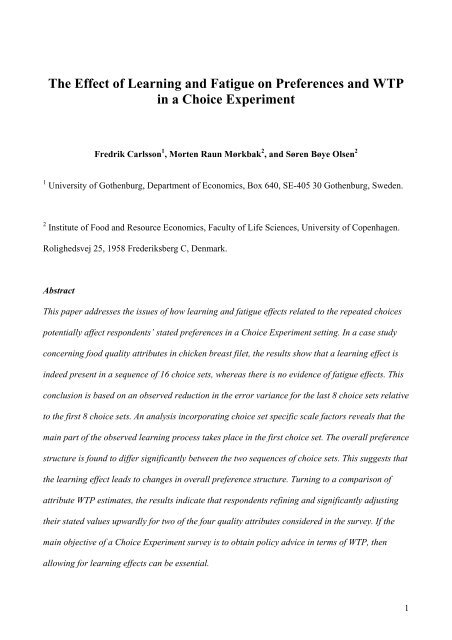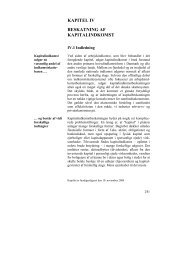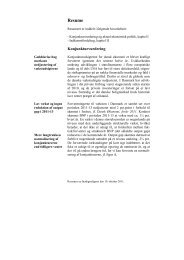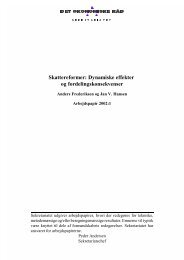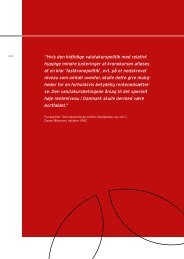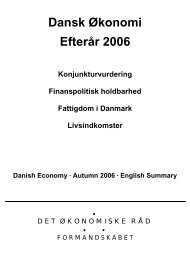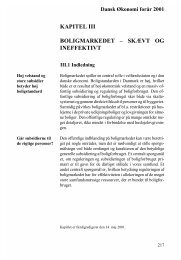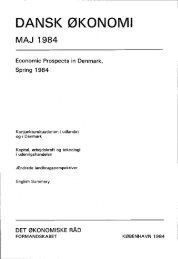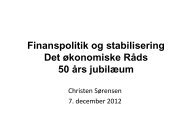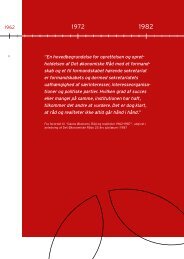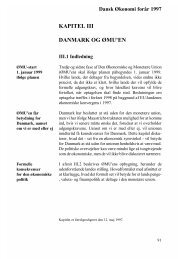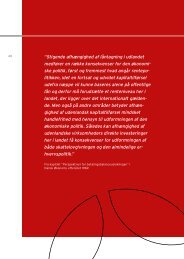The Effect of Learning and Fatigue on Preferences and WTP in a ...
The Effect of Learning and Fatigue on Preferences and WTP in a ...
The Effect of Learning and Fatigue on Preferences and WTP in a ...
Create successful ePaper yourself
Turn your PDF publications into a flip-book with our unique Google optimized e-Paper software.
<str<strong>on</strong>g>The</str<strong>on</strong>g> <str<strong>on</strong>g>Effect</str<strong>on</strong>g> <str<strong>on</strong>g>of</str<strong>on</strong>g> <str<strong>on</strong>g>Learn<strong>in</strong>g</str<strong>on</strong>g> <str<strong>on</strong>g>and</str<strong>on</strong>g> <str<strong>on</strong>g>Fatigue</str<strong>on</strong>g> <strong>on</strong> <strong>Preferences</strong> <str<strong>on</strong>g>and</str<strong>on</strong>g> <strong>WTP</strong><br />
<strong>in</strong> a Choice Experiment<br />
Fredrik Carlss<strong>on</strong> 1 , Morten Raun Mørkbak 2 , <str<strong>on</strong>g>and</str<strong>on</strong>g> Søren Bøye Olsen 2<br />
1 University <str<strong>on</strong>g>of</str<strong>on</strong>g> Gothenburg, Department <str<strong>on</strong>g>of</str<strong>on</strong>g> Ec<strong>on</strong>omics, Box 640, SE-405 30 Gothenburg, Sweden.<br />
2 Institute <str<strong>on</strong>g>of</str<strong>on</strong>g> Food <str<strong>on</strong>g>and</str<strong>on</strong>g> Resource Ec<strong>on</strong>omics, Faculty <str<strong>on</strong>g>of</str<strong>on</strong>g> Life Sciences, University <str<strong>on</strong>g>of</str<strong>on</strong>g> Copenhagen.<br />
Rolighedsvej 25, 1958 Frederiksberg C, Denmark.<br />
Abstract<br />
This paper addresses the issues <str<strong>on</strong>g>of</str<strong>on</strong>g> how learn<strong>in</strong>g <str<strong>on</strong>g>and</str<strong>on</strong>g> fatigue effects related to the repeated choices<br />
potentially affect resp<strong>on</strong>dents’ stated preferences <strong>in</strong> a Choice Experiment sett<strong>in</strong>g. In a case study<br />
c<strong>on</strong>cern<strong>in</strong>g food quality attributes <strong>in</strong> chicken breast filet, the results show that a learn<strong>in</strong>g effect is<br />
<strong>in</strong>deed present <strong>in</strong> a sequence <str<strong>on</strong>g>of</str<strong>on</strong>g> 16 choice sets, whereas there is no evidence <str<strong>on</strong>g>of</str<strong>on</strong>g> fatigue effects. This<br />
c<strong>on</strong>clusi<strong>on</strong> is based <strong>on</strong> an observed reducti<strong>on</strong> <strong>in</strong> the error variance for the last 8 choice sets relative<br />
to the first 8 choice sets. An analysis <strong>in</strong>corporat<strong>in</strong>g choice set specific scale factors reveals that the<br />
ma<strong>in</strong> part <str<strong>on</strong>g>of</str<strong>on</strong>g> the observed learn<strong>in</strong>g process takes place <strong>in</strong> the first choice set. <str<strong>on</strong>g>The</str<strong>on</strong>g> overall preference<br />
structure is found to differ significantly between the two sequences <str<strong>on</strong>g>of</str<strong>on</strong>g> choice sets. This suggests that<br />
the learn<strong>in</strong>g effect leads to changes <strong>in</strong> overall preference structure. Turn<strong>in</strong>g to a comparis<strong>on</strong> <str<strong>on</strong>g>of</str<strong>on</strong>g><br />
attribute <strong>WTP</strong> estimates, the results <strong>in</strong>dicate that resp<strong>on</strong>dents ref<strong>in</strong><strong>in</strong>g <str<strong>on</strong>g>and</str<strong>on</strong>g> significantly adjust<strong>in</strong>g<br />
their stated values upwardly for two <str<strong>on</strong>g>of</str<strong>on</strong>g> the four quality attributes c<strong>on</strong>sidered <strong>in</strong> the survey. If the<br />
ma<strong>in</strong> objective <str<strong>on</strong>g>of</str<strong>on</strong>g> a Choice Experiment survey is to obta<strong>in</strong> policy advice <strong>in</strong> terms <str<strong>on</strong>g>of</str<strong>on</strong>g> <strong>WTP</strong>, then<br />
allow<strong>in</strong>g for learn<strong>in</strong>g effects can be essential.<br />
1
1. Introducti<strong>on</strong><br />
Ample experimental <str<strong>on</strong>g>and</str<strong>on</strong>g> stated preference evidence suggests that people do make <strong>in</strong>coherent<br />
choices, that they are affected by for example the c<strong>on</strong>text, <str<strong>on</strong>g>and</str<strong>on</strong>g> various cues. This is clearly at odds<br />
with st<str<strong>on</strong>g>and</str<strong>on</strong>g>ard assumpti<strong>on</strong>s <strong>in</strong> ec<strong>on</strong>omics, <str<strong>on</strong>g>and</str<strong>on</strong>g> also with the assumpti<strong>on</strong>s we make when analys<strong>in</strong>g<br />
stated preference resp<strong>on</strong>ses. One hypothesis set forth expla<strong>in</strong><strong>in</strong>g some <str<strong>on</strong>g>of</str<strong>on</strong>g> these anomalies is the<br />
Discovered Preference Hypothesis (DPH) (Braga & Starmer 2005, Plott 1996). <str<strong>on</strong>g>The</str<strong>on</strong>g> DPH states that<br />
when resp<strong>on</strong>dents are faced with new decisi<strong>on</strong>s <strong>in</strong> unfamiliar envir<strong>on</strong>ments, <strong>in</strong>itial decisi<strong>on</strong>s will be<br />
<strong>in</strong>coherent <str<strong>on</strong>g>and</str<strong>on</strong>g> exhibit large r<str<strong>on</strong>g>and</str<strong>on</strong>g>omness. However, as choices are repeated <str<strong>on</strong>g>and</str<strong>on</strong>g> resp<strong>on</strong>dents ga<strong>in</strong><br />
familiarity with the decisi<strong>on</strong> envir<strong>on</strong>ment, decisi<strong>on</strong>s will progressively be more coherent <str<strong>on</strong>g>and</str<strong>on</strong>g> less<br />
r<str<strong>on</strong>g>and</str<strong>on</strong>g>om. It is thus argued that by “tra<strong>in</strong><strong>in</strong>g” resp<strong>on</strong>dents their preferences become more stable,<br />
which is also denoted as a learn<strong>in</strong>g effect (Cumm<strong>in</strong>gs et al. 1986). However, a counteract<strong>in</strong>g effect<br />
<strong>in</strong> the sett<strong>in</strong>g <str<strong>on</strong>g>of</str<strong>on</strong>g> a stated preference survey is fatigue. Resp<strong>on</strong>dents could get tired <str<strong>on</strong>g>of</str<strong>on</strong>g> the task, <str<strong>on</strong>g>and</str<strong>on</strong>g><br />
thus mak<strong>in</strong>g more r<str<strong>on</strong>g>and</str<strong>on</strong>g>om choices over the sequence <str<strong>on</strong>g>of</str<strong>on</strong>g> choice tasks.<br />
<str<strong>on</strong>g>Learn<strong>in</strong>g</str<strong>on</strong>g> effects has been discussed widely <strong>in</strong> the ec<strong>on</strong>omic valuati<strong>on</strong> literature – <strong>in</strong>itially <strong>in</strong> the<br />
c<strong>on</strong>text <str<strong>on</strong>g>of</str<strong>on</strong>g> c<strong>on</strong>t<strong>in</strong>gent valuati<strong>on</strong> surveys (CVM), see e.g. Bateman et al. (2008a), Bergstrom & Stoll<br />
(1989), or Bjornstad et al. (1997). <str<strong>on</strong>g>The</str<strong>on</strong>g> issue <str<strong>on</strong>g>of</str<strong>on</strong>g> learn<strong>in</strong>g <str<strong>on</strong>g>and</str<strong>on</strong>g> fatigue is, however, <str<strong>on</strong>g>of</str<strong>on</strong>g> greater <strong>in</strong>terest<br />
when subjects hare mak<strong>in</strong>g repeated choices such as <strong>in</strong> double-bounded CVM <str<strong>on</strong>g>and</str<strong>on</strong>g> <strong>in</strong> particular<br />
choice experiments (CEs). C<strong>on</strong>sequently, these issues have received a fair amount <str<strong>on</strong>g>of</str<strong>on</strong>g> attenti<strong>on</strong> <strong>in</strong><br />
the CE literature (Bateman et al. 2008b, Brouwer et al. 2009, Carlss<strong>on</strong> & Mart<strong>in</strong>ss<strong>on</strong> 2001, Dellaert<br />
et al. 1999, DeShazo & Fermo 2002, Hanley et al. 2002, Holmes & Boyle 2005, Johns<strong>on</strong> &<br />
B<strong>in</strong>gham 2001, Ladenburg & Olsen 2008, Lagerkvist et al. 2006, Phillips et al. 2002, Savage &<br />
2
Waldman 2008). However, results are ambiguous. <str<strong>on</strong>g>The</str<strong>on</strong>g> majority <str<strong>on</strong>g>of</str<strong>on</strong>g> these papers have exam<strong>in</strong>ed<br />
learn<strong>in</strong>g <str<strong>on</strong>g>and</str<strong>on</strong>g> fatigue effects by compar<strong>in</strong>g the choices made <strong>in</strong> identical choice sets presented at<br />
different positi<strong>on</strong>s <strong>in</strong> a sequence <str<strong>on</strong>g>of</str<strong>on</strong>g> choice sets. <str<strong>on</strong>g>The</str<strong>on</strong>g> traditi<strong>on</strong>al assumpti<strong>on</strong> <str<strong>on</strong>g>of</str<strong>on</strong>g> stable preferences<br />
entails that the choice should be the same regardless <str<strong>on</strong>g>of</str<strong>on</strong>g> the locati<strong>on</strong> <strong>in</strong> the sequence <str<strong>on</strong>g>of</str<strong>on</strong>g> choices.<br />
<str<strong>on</strong>g>Learn<strong>in</strong>g</str<strong>on</strong>g> <str<strong>on</strong>g>and</str<strong>on</strong>g> fatigue effects would violate this assumpti<strong>on</strong> <str<strong>on</strong>g>and</str<strong>on</strong>g> could result <strong>in</strong> choices be<strong>in</strong>g<br />
dependent <strong>on</strong> the locati<strong>on</strong> <strong>in</strong> the choice set sequence.<br />
From an ec<strong>on</strong>ometrics po<strong>in</strong>t <str<strong>on</strong>g>of</str<strong>on</strong>g> view <str<strong>on</strong>g>of</str<strong>on</strong>g> the r<str<strong>on</strong>g>and</str<strong>on</strong>g>om utility framework, identical repeated choice<br />
tasks should result <strong>in</strong> identical choices (Bateman et al. 2008b). However, from the psychology po<strong>in</strong>t<br />
<str<strong>on</strong>g>of</str<strong>on</strong>g> view there is a true r<str<strong>on</strong>g>and</str<strong>on</strong>g>om comp<strong>on</strong>ent <strong>in</strong> the r<str<strong>on</strong>g>and</str<strong>on</strong>g>om utility framework, so it would be expected<br />
that some deviati<strong>on</strong>s would exist (Bateman et al. 2008b). Because <str<strong>on</strong>g>of</str<strong>on</strong>g> this Bateman et al. (2008b)<br />
also argue that from an ec<strong>on</strong>omic po<strong>in</strong>t <str<strong>on</strong>g>of</str<strong>on</strong>g> view, a test <str<strong>on</strong>g>of</str<strong>on</strong>g> whether or not preferences have changed<br />
would be a more relevant test than whether or not choices have changed. In the present paper we<br />
add to the exist<strong>in</strong>g literature by provid<strong>in</strong>g an <strong>in</strong>ternal test for potential learn<strong>in</strong>g <str<strong>on</strong>g>and</str<strong>on</strong>g>/or fatigue<br />
effects. Specifically, we do not <strong>on</strong>ly exam<strong>in</strong>e the potential changes <strong>in</strong> the preference structure<br />
throughout the choice set sequence as has been d<strong>on</strong>e <strong>in</strong> the majority <str<strong>on</strong>g>of</str<strong>on</strong>g> the previous studies <strong>on</strong> this<br />
subject; to our knowledge we are the first to provide an <strong>in</strong>ternal test for potential changes <strong>in</strong> the<br />
will<strong>in</strong>gness-to-pay (<strong>WTP</strong>) estimates caused by the choice set sequence, i.e. the impact <str<strong>on</strong>g>of</str<strong>on</strong>g> learn<strong>in</strong>g<br />
<str<strong>on</strong>g>and</str<strong>on</strong>g>/or fatigue effects <strong>on</strong> obta<strong>in</strong>ed policy advice. In a case c<strong>on</strong>sider<strong>in</strong>g food safety attributes <str<strong>on</strong>g>of</str<strong>on</strong>g><br />
chicken breast filet, we apply an experimental setup us<strong>in</strong>g 16 CS per resp<strong>on</strong>dent where the last<br />
sequence <str<strong>on</strong>g>of</str<strong>on</strong>g> 8 CS is an exact copy <str<strong>on</strong>g>of</str<strong>on</strong>g> the first sequence <str<strong>on</strong>g>of</str<strong>on</strong>g> 8 CS. <str<strong>on</strong>g>The</str<strong>on</strong>g> advantage <str<strong>on</strong>g>of</str<strong>on</strong>g> repeat<strong>in</strong>g exactly<br />
the same choice sets is that it limits the <strong>in</strong>fluence <str<strong>on</strong>g>of</str<strong>on</strong>g> sequenc<strong>in</strong>g <str<strong>on</strong>g>of</str<strong>on</strong>g> the choice sets. On the other<br />
h<str<strong>on</strong>g>and</str<strong>on</strong>g>, there is an additi<strong>on</strong>al counter act<strong>in</strong>g effect to learn<strong>in</strong>g with our design <str<strong>on</strong>g>and</str<strong>on</strong>g> that is resp<strong>on</strong>dents<br />
desire to act <strong>in</strong> a coherent way. This is what Ariely et al. (2003) call coherent arbitrar<strong>in</strong>ess, i.e. an<br />
3
<strong>in</strong>dividual’s choices can be <strong>in</strong>ternally coherent, but at the same time they can be anchored <strong>on</strong> the<br />
first choice or some <strong>in</strong>itial start<strong>in</strong>g po<strong>in</strong>t.<br />
Our results suggest that a learn<strong>in</strong>g effect is present. This is observed through a reducti<strong>on</strong> <strong>in</strong> the error<br />
variance for the last 8 CS relative to the first 8 CS. Moreover the results show that the overall<br />
preference structure differs between the two sequences <str<strong>on</strong>g>of</str<strong>on</strong>g> choice sets, <str<strong>on</strong>g>and</str<strong>on</strong>g> further analysis showed<br />
that the <strong>WTP</strong> estimates were affected to some degree. We f<strong>in</strong>d not evidence <str<strong>on</strong>g>of</str<strong>on</strong>g> fatigue effects <strong>in</strong> the<br />
applied sequence <str<strong>on</strong>g>of</str<strong>on</strong>g> 16 CS. While our results imply that learn<strong>in</strong>g effects can <strong>in</strong>deed be <str<strong>on</strong>g>of</str<strong>on</strong>g> significant<br />
structural importance when c<strong>on</strong>duct<strong>in</strong>g CE surveys, our results also underl<strong>in</strong>e that if focus is solely<br />
<strong>on</strong> obta<strong>in</strong><strong>in</strong>g policy advice <strong>in</strong> terms <str<strong>on</strong>g>of</str<strong>on</strong>g> <strong>WTP</strong> estimates, learn<strong>in</strong>g effects are not negligible.<br />
<str<strong>on</strong>g>The</str<strong>on</strong>g> paper is organized as follows. <str<strong>on</strong>g>The</str<strong>on</strong>g> follow<strong>in</strong>g secti<strong>on</strong> provides an overview <str<strong>on</strong>g>of</str<strong>on</strong>g> the exist<strong>in</strong>g<br />
literature deal<strong>in</strong>g with learn<strong>in</strong>g <str<strong>on</strong>g>and</str<strong>on</strong>g> fatigue effects <strong>in</strong> CE. Secti<strong>on</strong> 3 briefly describes the method<br />
used <strong>in</strong> the survey <str<strong>on</strong>g>and</str<strong>on</strong>g> the theory beh<strong>in</strong>d the method. In secti<strong>on</strong> 4 the design <str<strong>on</strong>g>of</str<strong>on</strong>g> the survey <str<strong>on</strong>g>and</str<strong>on</strong>g> the<br />
data are described, followed by presentati<strong>on</strong> <str<strong>on</strong>g>of</str<strong>on</strong>g> the results <strong>in</strong> secti<strong>on</strong> 5. F<strong>in</strong>ally we discuss <str<strong>on</strong>g>and</str<strong>on</strong>g><br />
c<strong>on</strong>clude <strong>in</strong> secti<strong>on</strong> 6.<br />
2. Exist<strong>in</strong>g evidence <str<strong>on</strong>g>of</str<strong>on</strong>g> learn<strong>in</strong>g <str<strong>on</strong>g>and</str<strong>on</strong>g> fatigue effects <strong>in</strong> CE<br />
In a split sample CE study, Ladenburg & Olsen (2008) f<strong>in</strong>d evidence <str<strong>on</strong>g>of</str<strong>on</strong>g> start<strong>in</strong>g po<strong>in</strong>t bias, but the<br />
impact <str<strong>on</strong>g>of</str<strong>on</strong>g> this anomaly decays as more choice sets are evaluated. <str<strong>on</strong>g>The</str<strong>on</strong>g>y c<strong>on</strong>clude that a learn<strong>in</strong>g<br />
effect effectively reduces the bias. This is clearly <strong>in</strong> accordance with the DPH. Previous studies<br />
c<strong>on</strong>cern<strong>in</strong>g the DPH <strong>in</strong>terpretati<strong>on</strong> <str<strong>on</strong>g>of</str<strong>on</strong>g> decay<strong>in</strong>g anomalies have found similar results. In a literature<br />
review, Braga & Starmer (2005) f<strong>in</strong>d some, though not unequivocal, support for the DPH. Cherry et<br />
al. (2003) <str<strong>on</strong>g>and</str<strong>on</strong>g> List (2003) f<strong>in</strong>d that people generally become more rati<strong>on</strong>al through ref<strong>in</strong><strong>in</strong>g values,<br />
4
not by chang<strong>in</strong>g preferences as have been suggested from a c<strong>on</strong>structed preference or prospect<br />
theory view (Slovic 1995, Kahneman & Tversky 1979, Tversky & Kahneman 1986). In other terms,<br />
the stated values become more c<strong>on</strong>sistent with the true preferences as market experience <strong>in</strong>creases<br />
through a process <str<strong>on</strong>g>of</str<strong>on</strong>g> repetiti<strong>on</strong> <str<strong>on</strong>g>and</str<strong>on</strong>g> learn<strong>in</strong>g.<br />
Dellaert et al. (1999) <str<strong>on</strong>g>and</str<strong>on</strong>g> DeShazo & Fermo (2002) both exam<strong>in</strong>e the effect <str<strong>on</strong>g>of</str<strong>on</strong>g> different choice set<br />
designs (complexity) <strong>on</strong> c<strong>on</strong>sumer choice c<strong>on</strong>sistency <str<strong>on</strong>g>and</str<strong>on</strong>g> f<strong>in</strong>d that <strong>in</strong>creased cognitive burden are<br />
associated with an <strong>in</strong>crease <strong>in</strong> the error variance, which they <strong>in</strong>terpret as decrease <strong>in</strong> choice<br />
c<strong>on</strong>sistency. Lagerkvist et al. (2006) use a b<strong>in</strong>ary heteroskedastic logit model to account for<br />
differences <strong>in</strong> the error variance between the first 3 choice sets (CS) <str<strong>on</strong>g>and</str<strong>on</strong>g> the last 3 CS <strong>in</strong> a CE<br />
survey. <str<strong>on</strong>g>The</str<strong>on</strong>g>y f<strong>in</strong>d a higher variance for the sec<strong>on</strong>d half <str<strong>on</strong>g>of</str<strong>on</strong>g> the experiment <str<strong>on</strong>g>and</str<strong>on</strong>g> c<strong>on</strong>clude that this is<br />
due to resp<strong>on</strong>dents gett<strong>in</strong>g fatigued <str<strong>on</strong>g>and</str<strong>on</strong>g> lose <strong>in</strong>terest <strong>in</strong> the end <str<strong>on</strong>g>of</str<strong>on</strong>g> the experiment. This f<strong>in</strong>d<strong>in</strong>g is<br />
supported by the f<strong>in</strong>d<strong>in</strong>gs <strong>in</strong> Savage & Waldman (2008). <str<strong>on</strong>g>The</str<strong>on</strong>g>y also f<strong>in</strong>d that resp<strong>on</strong>dents suffer<br />
fatigue or boredom when they compare the error variance <strong>in</strong> the first 4 CS with the error variance <strong>in</strong><br />
the last 4 CS. Holmes & Boyle (2005) use an attribute-based referenda approach, which is a<br />
comb<strong>in</strong>ati<strong>on</strong> <str<strong>on</strong>g>of</str<strong>on</strong>g> a choice experiment <str<strong>on</strong>g>and</str<strong>on</strong>g> a dichotomous choice questi<strong>on</strong> with a sequence <str<strong>on</strong>g>of</str<strong>on</strong>g> four<br />
“choice sets” presented to each resp<strong>on</strong>dent. <str<strong>on</strong>g>The</str<strong>on</strong>g>y test the error variance <str<strong>on</strong>g>of</str<strong>on</strong>g> the first valuati<strong>on</strong><br />
questi<strong>on</strong> aga<strong>in</strong>st the error variance <str<strong>on</strong>g>of</str<strong>on</strong>g> the sec<strong>on</strong>d, third <str<strong>on</strong>g>and</str<strong>on</strong>g> fourth valuati<strong>on</strong> questi<strong>on</strong>, respectively,<br />
<str<strong>on</strong>g>and</str<strong>on</strong>g> f<strong>in</strong>d <strong>on</strong>ly the error variance <str<strong>on</strong>g>of</str<strong>on</strong>g> the first <str<strong>on</strong>g>and</str<strong>on</strong>g> fourth valuati<strong>on</strong> questi<strong>on</strong> to differ, with the variance<br />
<strong>in</strong> the latter be<strong>in</strong>g the smallest, suggest<strong>in</strong>g a learn<strong>in</strong>g effect. Carlss<strong>on</strong> & Mart<strong>in</strong>ss<strong>on</strong> (2001) exam<strong>in</strong>e<br />
learn<strong>in</strong>g <strong>in</strong> a CE c<strong>on</strong>ducted both <strong>on</strong> hypothetical market <str<strong>on</strong>g>and</str<strong>on</strong>g> <strong>on</strong> an actual market, by divid<strong>in</strong>g the 16<br />
CS <strong>in</strong>to two sequences <str<strong>on</strong>g>of</str<strong>on</strong>g> 8 (A, B). <str<strong>on</strong>g>The</str<strong>on</strong>g>y then compare model results <str<strong>on</strong>g>of</str<strong>on</strong>g> sequence B data <strong>in</strong> a split<br />
sample design <strong>in</strong> which resp<strong>on</strong>dents have received sequence B as the first <str<strong>on</strong>g>and</str<strong>on</strong>g> as the last 8 CS<br />
respectively. <str<strong>on</strong>g>The</str<strong>on</strong>g>y f<strong>in</strong>d no differences between the scale parameters <strong>in</strong> the two models, neither <strong>in</strong><br />
5
the hypothetical market case nor <strong>in</strong> the actual market case, suggest<strong>in</strong>g no learn<strong>in</strong>g or fatigue effect<br />
be<strong>in</strong>g present. Compar<strong>in</strong>g a sequence <str<strong>on</strong>g>of</str<strong>on</strong>g> four CS with a sequence <str<strong>on</strong>g>of</str<strong>on</strong>g> eight CS, Hanley et al. (2002)<br />
f<strong>in</strong>d <strong>on</strong>ly very weak evidence that the number <str<strong>on</strong>g>of</str<strong>on</strong>g> CS affects preferences <strong>in</strong> any way. Further, they<br />
f<strong>in</strong>d no significant impact <strong>on</strong> <strong>WTP</strong> measures, aga<strong>in</strong> suggest<strong>in</strong>g that no learn<strong>in</strong>g or fatigue effect is<br />
present. Similarly, Johns<strong>on</strong> & B<strong>in</strong>gham (2001) compare <strong>WTP</strong> estimates obta<strong>in</strong>ed from the<br />
beg<strong>in</strong>n<strong>in</strong>g <str<strong>on</strong>g>and</str<strong>on</strong>g> last end <str<strong>on</strong>g>of</str<strong>on</strong>g> a sequence <str<strong>on</strong>g>of</str<strong>on</strong>g> SP questi<strong>on</strong>s <str<strong>on</strong>g>and</str<strong>on</strong>g> f<strong>in</strong>d no significant differences.<br />
In a repeated choice experiment Brouwer et al. (2009) exam<strong>in</strong>e learn<strong>in</strong>g over five CS with the first<br />
<str<strong>on</strong>g>and</str<strong>on</strong>g> the last CS be<strong>in</strong>g identical. <str<strong>on</strong>g>The</str<strong>on</strong>g>y also exam<strong>in</strong>e a learn<strong>in</strong>g effect through the size <str<strong>on</strong>g>of</str<strong>on</strong>g> the error<br />
variance, <str<strong>on</strong>g>and</str<strong>on</strong>g> f<strong>in</strong>d no differences <strong>in</strong> the variance throughout the five CS, <str<strong>on</strong>g>and</str<strong>on</strong>g> hence no learn<strong>in</strong>g or<br />
fatigue effect. In additi<strong>on</strong>, they test the stability <str<strong>on</strong>g>of</str<strong>on</strong>g> preferences by compar<strong>in</strong>g the first <str<strong>on</strong>g>and</str<strong>on</strong>g> the fifth<br />
CS which is identical, <str<strong>on</strong>g>and</str<strong>on</strong>g> f<strong>in</strong>d no differences <strong>in</strong> the error variance here as well, although 27 % <str<strong>on</strong>g>of</str<strong>on</strong>g><br />
the resp<strong>on</strong>dents did chose another policy alternative <strong>in</strong> the fifth CS compared to the first CS.<br />
Phillips et al. (2002) use a similar approach, also add<strong>in</strong>g an identical first CS at the end <str<strong>on</strong>g>of</str<strong>on</strong>g> the CE.<br />
<str<strong>on</strong>g>The</str<strong>on</strong>g>y <strong>on</strong>ly exam<strong>in</strong>e the rate <str<strong>on</strong>g>of</str<strong>on</strong>g> the same alternative be<strong>in</strong>g chosen <strong>in</strong> the last CS, <str<strong>on</strong>g>and</str<strong>on</strong>g> they f<strong>in</strong>d that 75<br />
% <str<strong>on</strong>g>of</str<strong>on</strong>g> the resp<strong>on</strong>dents choose the same alternative <strong>in</strong> the last CS as they did <strong>in</strong> the first CS. Bateman<br />
et al. (2008b) also analyses the effect <str<strong>on</strong>g>of</str<strong>on</strong>g> add<strong>in</strong>g <strong>in</strong> an identical first CS as the last choice, result<strong>in</strong>g<br />
<strong>in</strong> 17 CS <strong>in</strong> total for each resp<strong>on</strong>dent. <str<strong>on</strong>g>The</str<strong>on</strong>g>y f<strong>in</strong>d that resp<strong>on</strong>dents are less likely to choose an<br />
identical alternative when it is placed <strong>in</strong> the end <str<strong>on</strong>g>of</str<strong>on</strong>g> a choice sequence, <str<strong>on</strong>g>and</str<strong>on</strong>g> furthermore that the<br />
effect <strong>on</strong> the marg<strong>in</strong>al utility <str<strong>on</strong>g>of</str<strong>on</strong>g> a given alternative is lower when placed <strong>in</strong> the end <str<strong>on</strong>g>of</str<strong>on</strong>g> the choice set<br />
sequence. F<strong>in</strong>ally they exam<strong>in</strong>e a heteroskedastic mult<strong>in</strong>omial logit model <strong>in</strong> which 16 orderspecific<br />
scale parameters were estimated. <str<strong>on</strong>g>The</str<strong>on</strong>g> results <str<strong>on</strong>g>of</str<strong>on</strong>g> this showed that <strong>on</strong>ly the scale factors for<br />
choice tasks 3, 9, <str<strong>on</strong>g>and</str<strong>on</strong>g> 16 were statistically significantly different from <strong>on</strong>e at the usual significance<br />
level (0.05). On the basis <str<strong>on</strong>g>of</str<strong>on</strong>g> this they c<strong>on</strong>clude that the most reliable estimates are found <strong>in</strong> the<br />
6
eg<strong>in</strong>n<strong>in</strong>g <str<strong>on</strong>g>and</str<strong>on</strong>g> <strong>in</strong> the end <str<strong>on</strong>g>of</str<strong>on</strong>g> the choice task sequence, so the approach <str<strong>on</strong>g>of</str<strong>on</strong>g> us<strong>in</strong>g order-specific scale<br />
parameters to support a learn<strong>in</strong>g hypothesis failed.<br />
3. Method<br />
<str<strong>on</strong>g>The</str<strong>on</strong>g> underly<strong>in</strong>g theory <str<strong>on</strong>g>of</str<strong>on</strong>g> CE is based <strong>on</strong> Lancaster’s C<strong>on</strong>sumer <str<strong>on</strong>g>The</str<strong>on</strong>g>ory (LCT) (Lancaster 1966) <str<strong>on</strong>g>and</str<strong>on</strong>g><br />
r<str<strong>on</strong>g>and</str<strong>on</strong>g>om utility theory (Gravelle & Rees 1992, Luce 1959, McFadden 1974). Accord<strong>in</strong>g to<br />
Lancaster, the (<strong>in</strong>direct) utility V ij that <strong>in</strong>dividual i achieves from good j is the sum <str<strong>on</strong>g>of</str<strong>on</strong>g> the utilities<br />
obta<strong>in</strong>ed from each <str<strong>on</strong>g>of</str<strong>on</strong>g> the K characteristics s kij . Assum<strong>in</strong>g l<strong>in</strong>earity <strong>in</strong> the valuati<strong>on</strong> <str<strong>on</strong>g>of</str<strong>on</strong>g> attributes, the<br />
utility V ij can be written as follows:<br />
V = β1s1 + β2 s2 + .......... + β s<br />
ij i ij i ij Ki Kij<br />
(1)<br />
<str<strong>on</strong>g>The</str<strong>on</strong>g> parameter β ki represents the weight by which attribute k is valued by <strong>in</strong>dividual i 1 . In r<str<strong>on</strong>g>and</str<strong>on</strong>g>om<br />
utility theory, it is assumed that <strong>in</strong>dividuals make choices accord<strong>in</strong>g to a determ<strong>in</strong>istic part al<strong>on</strong>g<br />
with some degree <str<strong>on</strong>g>of</str<strong>on</strong>g> r<str<strong>on</strong>g>and</str<strong>on</strong>g>omness. Allow<strong>in</strong>g U ij to represent the r<str<strong>on</strong>g>and</str<strong>on</strong>g>om utility that <strong>in</strong>dividual i<br />
places <strong>on</strong> alternative j, V ij now represents the determ<strong>in</strong>istic comp<strong>on</strong>ent <str<strong>on</strong>g>of</str<strong>on</strong>g> the utility functi<strong>on</strong> <str<strong>on</strong>g>and</str<strong>on</strong>g> ε ij<br />
is a r<str<strong>on</strong>g>and</str<strong>on</strong>g>om variable that captures the unsystematic <str<strong>on</strong>g>and</str<strong>on</strong>g> unobserved r<str<strong>on</strong>g>and</str<strong>on</strong>g>om element <str<strong>on</strong>g>of</str<strong>on</strong>g> <strong>in</strong>dividual<br />
i’s choice (Hanley et al. 2002, Holmes & Adamowicz 2003). We will assume throughout the paper<br />
that the error terms are <strong>in</strong>dependent Gumbel distributi<strong>on</strong>s. Hence, the r<str<strong>on</strong>g>and</str<strong>on</strong>g>om utility U ij can be<br />
represented as follows:<br />
U<br />
ij<br />
= β .......... +<br />
is<br />
ij<br />
+ β<br />
is<br />
ij<br />
+ + β<br />
KisKij<br />
ε<br />
(2)<br />
1 1 2 2<br />
ij<br />
1 Sometimes, the attribute weights differ between alternatives β kj but <strong>in</strong> the present study it was not mean<strong>in</strong>gful to<br />
operate with different attribute weights for the hypothetical alternatives.<br />
7
In a st<str<strong>on</strong>g>and</str<strong>on</strong>g>ard logit specificati<strong>on</strong>, all parameter coefficients are fixed whereas a r<str<strong>on</strong>g>and</str<strong>on</strong>g>om parameter<br />
logit (RPL) model, as we apply <strong>in</strong> this paper allows for variati<strong>on</strong>s <strong>in</strong> pers<strong>on</strong>al tastes. <str<strong>on</strong>g>The</str<strong>on</strong>g> researcher<br />
cannot observe β i for each <strong>in</strong>dividual so it is not possible to c<strong>on</strong>diti<strong>on</strong> <strong>on</strong> β i . However, by assum<strong>in</strong>g<br />
that the β i coefficients vary across resp<strong>on</strong>dents with the density f(β i ), it is possible to obta<strong>in</strong> the<br />
unc<strong>on</strong>diti<strong>on</strong>al probability P ij that <strong>in</strong>dividual i chooses alternative j, as the <strong>in</strong>tegral <str<strong>on</strong>g>of</str<strong>on</strong>g> the c<strong>on</strong>diti<strong>on</strong>al<br />
probability <strong>on</strong> β i over all possible values <str<strong>on</strong>g>of</str<strong>on</strong>g> β i :<br />
⎛ βi'<br />
S ⎞<br />
ij<br />
e<br />
Pij =<br />
⎜ ⎟<br />
f<br />
'<br />
( βi ) dβ<br />
β i<br />
i S<strong>in</strong><br />
e<br />
⎜ ⎟<br />
⎝ n ⎠<br />
∫ ∑ (3)<br />
We assume that all n<strong>on</strong>-price attributes are normally distributed thereby allow<strong>in</strong>g c<strong>on</strong>sumers to<br />
place positive as well as negative values <strong>on</strong> the n<strong>on</strong>-price attributes as well as the alternative<br />
specific c<strong>on</strong>stant, which has been shown to work well <strong>in</strong> earlier studies. <str<strong>on</strong>g>The</str<strong>on</strong>g> price coefficient is<br />
be<strong>in</strong>g held c<strong>on</strong>stant because such an assumpti<strong>on</strong> <str<strong>on</strong>g>of</str<strong>on</strong>g> a c<strong>on</strong>stant price parameter allows straight<br />
forward calculati<strong>on</strong>s <str<strong>on</strong>g>of</str<strong>on</strong>g> the distributi<strong>on</strong> <str<strong>on</strong>g>of</str<strong>on</strong>g> <strong>WTP</strong>.<br />
In test<strong>in</strong>g for a potential learn<strong>in</strong>g or fatigue effects we apply the Likelihood Ratio test procedure<br />
suggested by Swait & Louviere (1993) <str<strong>on</strong>g>and</str<strong>on</strong>g> draw <strong>on</strong> the noti<strong>on</strong> used by e.g. Holmes & Boyle (2005)<br />
<str<strong>on</strong>g>and</str<strong>on</strong>g> Savage & Waldman (2008) that larger error variance is caused by fatigue, while smaller error<br />
variance is caused by learn<strong>in</strong>g. In this test we compare a model based <strong>on</strong> the first 8 CS with a model<br />
based <strong>on</strong> the last 8 CS, but the test could easily be c<strong>on</strong>ducted <strong>on</strong> larger number <str<strong>on</strong>g>of</str<strong>on</strong>g> models with<strong>in</strong> the<br />
16 CS (see below for further details <strong>on</strong> the design). In the c<strong>on</strong>text <str<strong>on</strong>g>of</str<strong>on</strong>g> learn<strong>in</strong>g, it makes sense to<br />
assume that learn<strong>in</strong>g processes will lead to choices that exhibit a relatively lower degree <str<strong>on</strong>g>of</str<strong>on</strong>g><br />
8
unobserved variability, <str<strong>on</strong>g>and</str<strong>on</strong>g> thus a higher degree <str<strong>on</strong>g>of</str<strong>on</strong>g> estimati<strong>on</strong> precisi<strong>on</strong> (Hole 2006). It makes<br />
similarly good sense to assume that fatigue would have the opposite effect.<br />
Recall that the scale parameter is the <strong>in</strong>verse <str<strong>on</strong>g>of</str<strong>on</strong>g> the st<str<strong>on</strong>g>and</str<strong>on</strong>g>ard deviati<strong>on</strong> <str<strong>on</strong>g>of</str<strong>on</strong>g> the error term (Swait &<br />
Louviere 1993). This implies that the variance <str<strong>on</strong>g>of</str<strong>on</strong>g> the error term or “noise” can be estimated as 1/σ 2 .<br />
<str<strong>on</strong>g>The</str<strong>on</strong>g> coefficients (β) <strong>in</strong> the ec<strong>on</strong>ometric models are usually expressed <strong>in</strong> their scaled form<br />
*<br />
( β β σ )<br />
= , where the scale parameter σ <str<strong>on</strong>g>and</str<strong>on</strong>g> the ‘orig<strong>in</strong>al’ coefficients β * cannot be separately<br />
identified (Tra<strong>in</strong> 2003). <str<strong>on</strong>g>The</str<strong>on</strong>g> estimated parameter β <strong>in</strong>dicate the effect <str<strong>on</strong>g>of</str<strong>on</strong>g> each observed variable<br />
relative to the variance <str<strong>on</strong>g>of</str<strong>on</strong>g> the unobserved factors (Tra<strong>in</strong> 2003). To test for differences <strong>in</strong> scale, the<br />
differences have to be isolated before compar<strong>in</strong>g the parameters. <str<strong>on</strong>g>The</str<strong>on</strong>g> problem is though, that the<br />
scal<strong>in</strong>g factor cannot be identified <strong>in</strong> any particular set <str<strong>on</strong>g>of</str<strong>on</strong>g> empirical data. But <strong>in</strong>stead the ratio <str<strong>on</strong>g>of</str<strong>on</strong>g> the<br />
scale factor <str<strong>on</strong>g>of</str<strong>on</strong>g> <strong>on</strong>e data set relative to another can be identified by normaliz<strong>in</strong>g <strong>on</strong>e <str<strong>on</strong>g>of</str<strong>on</strong>g> them to the<br />
value <str<strong>on</strong>g>of</str<strong>on</strong>g> 1 <str<strong>on</strong>g>and</str<strong>on</strong>g> then def<strong>in</strong><strong>in</strong>g a range <str<strong>on</strong>g>of</str<strong>on</strong>g> values <str<strong>on</strong>g>of</str<strong>on</strong>g> the other scale factor, with<strong>in</strong> which we expect the<br />
log likelihood functi<strong>on</strong> to be maximized (Swait & Louviere 1993).<br />
In estimat<strong>in</strong>g the models we have used the s<str<strong>on</strong>g>of</str<strong>on</strong>g>tware package Biogeme (Bierlaire 2003), which<br />
allows for a direct estimati<strong>on</strong> <str<strong>on</strong>g>of</str<strong>on</strong>g> the ratio <str<strong>on</strong>g>of</str<strong>on</strong>g> scale factors. <str<strong>on</strong>g>The</str<strong>on</strong>g> models are estimated with simulated<br />
maximum likelihood us<strong>in</strong>g Halt<strong>on</strong> draws with 300 replicati<strong>on</strong>s; see Tra<strong>in</strong> (2003) for details <strong>on</strong><br />
simulated maximum likelihood <str<strong>on</strong>g>and</str<strong>on</strong>g> Halt<strong>on</strong> draws.<br />
4. Design<br />
9
Prior to the design <str<strong>on</strong>g>of</str<strong>on</strong>g> the CE, three focus group <strong>in</strong>terviews were performed 2 . In the focus groups the<br />
follow<strong>in</strong>g attributes were identified as be<strong>in</strong>g important <strong>in</strong> relati<strong>on</strong> to choice <str<strong>on</strong>g>of</str<strong>on</strong>g> chicken breast fillets:<br />
Type <str<strong>on</strong>g>of</str<strong>on</strong>g> producti<strong>on</strong>, country <str<strong>on</strong>g>of</str<strong>on</strong>g> orig<strong>in</strong> <str<strong>on</strong>g>and</str<strong>on</strong>g>, to some extent, food safety (ma<strong>in</strong>ly Salm<strong>on</strong>ella). Even<br />
though food safety did not appear to be <str<strong>on</strong>g>of</str<strong>on</strong>g> great c<strong>on</strong>cern to c<strong>on</strong>sumers, the orig<strong>in</strong>al purpose <str<strong>on</strong>g>of</str<strong>on</strong>g> the<br />
present study was to elicit the relative weight<strong>in</strong>g <str<strong>on</strong>g>of</str<strong>on</strong>g> food safety. C<strong>on</strong>sequently, we <strong>in</strong>cluded two<br />
food safety attributes associated with the chicken products: “Salm<strong>on</strong>ella-free” <str<strong>on</strong>g>and</str<strong>on</strong>g> “Campylobacterfree”.<br />
<str<strong>on</strong>g>The</str<strong>on</strong>g> two specific food safety attributes were chosen because <str<strong>on</strong>g>of</str<strong>on</strong>g> their relevance to each <str<strong>on</strong>g>of</str<strong>on</strong>g> the<br />
products <str<strong>on</strong>g>and</str<strong>on</strong>g> also because they were judged as represent<strong>in</strong>g an <strong>in</strong>creas<strong>in</strong>gly important issue from a<br />
scientific as well as a political perspective. <str<strong>on</strong>g>The</str<strong>on</strong>g> attributes <str<strong>on</strong>g>and</str<strong>on</strong>g> their associated levels are presented <strong>in</strong><br />
table 1.<br />
Table 1: <str<strong>on</strong>g>The</str<strong>on</strong>g> attributes <str<strong>on</strong>g>and</str<strong>on</strong>g> their levels <strong>in</strong> the Choice Experiment for the chicken breast fillet.<br />
Attributes<br />
Type <str<strong>on</strong>g>of</str<strong>on</strong>g> producti<strong>on</strong><br />
Country <str<strong>on</strong>g>of</str<strong>on</strong>g> orig<strong>in</strong><br />
Campylobacter-free<br />
Salm<strong>on</strong>ella-free<br />
Levels<br />
C<strong>on</strong>venti<strong>on</strong>al (<strong>in</strong>door), organic (outdoor)<br />
Domestic (Danish), N<strong>on</strong>-domestic<br />
Not labelled Campylobacter-free, Campylobacter-free<br />
Not labelled Salm<strong>on</strong>ella-free, Salm<strong>on</strong>ella-free<br />
Price (DKK) 25, 28, 33, 40, 50, 65, 85, 115<br />
Note: DKK 10 ~ EUR 1.34.<br />
<str<strong>on</strong>g>The</str<strong>on</strong>g> two food safety attributes <strong>in</strong> the survey, Salm<strong>on</strong>ella-free <str<strong>on</strong>g>and</str<strong>on</strong>g> Campylobacter-free are quite<br />
similar. <str<strong>on</strong>g>The</str<strong>on</strong>g>y both exhibit private good characteristic to a large extent, <str<strong>on</strong>g>and</str<strong>on</strong>g> both give rise to more or<br />
less the same course <str<strong>on</strong>g>of</str<strong>on</strong>g> illness. <str<strong>on</strong>g>The</str<strong>on</strong>g> ma<strong>in</strong> difference is that the current risk <str<strong>on</strong>g>of</str<strong>on</strong>g> gett<strong>in</strong>g <strong>in</strong>fected by<br />
Campylobacter is much higher than the risk <str<strong>on</strong>g>of</str<strong>on</strong>g> a Salm<strong>on</strong>ella <strong>in</strong>fecti<strong>on</strong>. C<strong>on</strong>sequently, our a priori<br />
2 <str<strong>on</strong>g>The</str<strong>on</strong>g> focus groups were headed by the sociologist Korzen, S., Department <str<strong>on</strong>g>of</str<strong>on</strong>g> Human Nutriti<strong>on</strong>, University <str<strong>on</strong>g>of</str<strong>on</strong>g><br />
Copenhagen, who works with qualitative studies <strong>on</strong> food percepti<strong>on</strong>s.<br />
10
expectati<strong>on</strong> <str<strong>on</strong>g>of</str<strong>on</strong>g> the value <str<strong>on</strong>g>of</str<strong>on</strong>g> a Salm<strong>on</strong>ella-free chicken is that resp<strong>on</strong>dents will not value it as highly<br />
as the Campylobacter-free characteristic.<br />
A D-optimal fracti<strong>on</strong>al factorial design result<strong>in</strong>g <strong>in</strong> a sequence <str<strong>on</strong>g>of</str<strong>on</strong>g> 8 CS was used for the<br />
experimental design. At the end <str<strong>on</strong>g>of</str<strong>on</strong>g> this sequence, the entire sequence <str<strong>on</strong>g>of</str<strong>on</strong>g> 8 CS was repeated,<br />
result<strong>in</strong>g <strong>in</strong> a total <str<strong>on</strong>g>of</str<strong>on</strong>g> 16 choice sets per resp<strong>on</strong>dent. Hence the fracti<strong>on</strong>al factorial design <str<strong>on</strong>g>of</str<strong>on</strong>g> 8 CS<br />
was actually presented twice to each resp<strong>on</strong>dent. Resp<strong>on</strong>dents were not made explicitly aware <str<strong>on</strong>g>of</str<strong>on</strong>g><br />
this feature <str<strong>on</strong>g>of</str<strong>on</strong>g> the design. In each choice set, the resp<strong>on</strong>dents were faced with two alternative<br />
chicken breasts fillet products plus a third status quo alternative (all specified as packages <str<strong>on</strong>g>of</str<strong>on</strong>g> 500<br />
grams). <str<strong>on</strong>g>The</str<strong>on</strong>g> latter characterised the resp<strong>on</strong>dents’ usual purchase, which was identified earlier <strong>in</strong> the<br />
questi<strong>on</strong>naire. This approach <str<strong>on</strong>g>of</str<strong>on</strong>g> us<strong>in</strong>g the resp<strong>on</strong>dents’ ”own” status quo values has been<br />
recommended <str<strong>on</strong>g>and</str<strong>on</strong>g> used <strong>in</strong> other studies to mimic the actual purchas<strong>in</strong>g situati<strong>on</strong> as closely as<br />
possible (K<strong>on</strong>tole<strong>on</strong> & Yabe 2003, Ruby et al. 1998). <str<strong>on</strong>g>The</str<strong>on</strong>g> use <str<strong>on</strong>g>of</str<strong>on</strong>g> <strong>in</strong>dividual specific status quo<br />
alternatives <strong>in</strong> the design procedure <str<strong>on</strong>g>of</str<strong>on</strong>g> CE have been further developed by Rose et al. (2008), <strong>in</strong><br />
what they refer to as segment-specific efficient designs, two-stage process designs <str<strong>on</strong>g>and</str<strong>on</strong>g> <strong>in</strong>dividual<br />
efficient designs.<br />
5. Results <str<strong>on</strong>g>and</str<strong>on</strong>g> discussi<strong>on</strong><br />
<str<strong>on</strong>g>The</str<strong>on</strong>g> CE survey was c<strong>on</strong>ducted us<strong>in</strong>g an <strong>in</strong>ternet panel. <str<strong>on</strong>g>The</str<strong>on</strong>g> sample was obta<strong>in</strong>ed from Nielsen’s<br />
<strong>on</strong>l<strong>in</strong>e database. In Denmark, there are approximately 2.4 milli<strong>on</strong> private households, <str<strong>on</strong>g>of</str<strong>on</strong>g> whom 87%<br />
are <strong>on</strong>l<strong>in</strong>e. <str<strong>on</strong>g>The</str<strong>on</strong>g> panel members are all aged 15 years or above, <str<strong>on</strong>g>and</str<strong>on</strong>g> they all reside <strong>in</strong> a household<br />
with <strong>in</strong>ternet access, but <strong>in</strong> the present survey <strong>on</strong>ly resp<strong>on</strong>dents above age 18 were allowed to<br />
participate. <str<strong>on</strong>g>The</str<strong>on</strong>g> f<strong>in</strong>al sample c<strong>on</strong>sisted <str<strong>on</strong>g>of</str<strong>on</strong>g> 389 resp<strong>on</strong>dents, each answer<strong>in</strong>g 16 CS result<strong>in</strong>g <strong>in</strong> a<br />
total <str<strong>on</strong>g>of</str<strong>on</strong>g> 6224 choice observati<strong>on</strong>s. <str<strong>on</strong>g>The</str<strong>on</strong>g> resp<strong>on</strong>se rate was 26 %.<br />
11
Initially, four RPL models are estimated:<br />
Model (i): based <strong>on</strong> the first 8 CS;<br />
Model (ii): based <strong>on</strong> the last 8 CS;<br />
Model (iii): based <strong>on</strong> all 16 CS, not account<strong>in</strong>g for potential difference <strong>in</strong> scale<br />
between the first <str<strong>on</strong>g>and</str<strong>on</strong>g> last 8 CS;<br />
Model (iv): based <strong>on</strong> all 16 CS, allow<strong>in</strong>g <str<strong>on</strong>g>and</str<strong>on</strong>g> account<strong>in</strong>g for potential difference <strong>in</strong><br />
scale between the first <str<strong>on</strong>g>and</str<strong>on</strong>g> last 8 CS.<br />
Table 2 displays the results obta<strong>in</strong>ed <strong>in</strong> the four different models.<br />
Table 2: RPL models for the first 8 <str<strong>on</strong>g>and</str<strong>on</strong>g> the last 8 CS, <str<strong>on</strong>g>and</str<strong>on</strong>g> models for <strong>in</strong>clud<strong>in</strong>g all 16 CS both with<br />
<str<strong>on</strong>g>and</str<strong>on</strong>g> without correcti<strong>on</strong>s for differences <strong>in</strong> scale.<br />
Variable<br />
Campylobacter-free label<br />
Salm<strong>on</strong>ella-free label<br />
Domestic produce<br />
Organic producti<strong>on</strong><br />
ASC (Status quo)<br />
Price<br />
St<str<strong>on</strong>g>and</str<strong>on</strong>g>ard Deviati<strong>on</strong><br />
Campylobacter-free label<br />
Model (i)<br />
First 8 CS<br />
Coefficients<br />
(Std. Err.)<br />
0.81<br />
(0.0668)<br />
0.62<br />
(0.081)<br />
1.192<br />
(0.0992)<br />
0.454<br />
(0.0952)<br />
0.142<br />
(0.13)<br />
-0.0375<br />
(0.00267)<br />
t-value<br />
12.13<br />
7.66<br />
12.01<br />
4.77<br />
1.09<br />
-14.07<br />
Model (ii)<br />
Last 8 CS<br />
Coefficients<br />
(Std. Err.)<br />
0.916<br />
(0.0886)<br />
0.95<br />
(0.1224)<br />
1.338<br />
(0.1604)<br />
0.764<br />
(0.1378)<br />
0.32<br />
(0.139)<br />
-0.0441<br />
(0.00368)<br />
t-value<br />
10.35<br />
7.76<br />
8.34<br />
5.55<br />
2.29<br />
-11.96<br />
Model (iii)<br />
All 16 CS - not<br />
corrected for scale<br />
Coefficients<br />
(Std. Err.) t-value<br />
1.252<br />
(0.103)<br />
12.16<br />
1.142<br />
(0.1338)<br />
8.55<br />
1.906<br />
(0.1778)<br />
10.73<br />
1.214<br />
(0.1732)<br />
7.01<br />
-0.36<br />
(0.165)<br />
-2.18<br />
-0.0549<br />
(0.00394)<br />
-13.92<br />
Model (iv)<br />
All 16 CS - corrected<br />
for scale<br />
Coefficients<br />
(Std. Err.)<br />
t-value<br />
0.432<br />
(0.0358)<br />
12.05<br />
0.396<br />
(0.0458)<br />
8.63<br />
0.658<br />
(0.0624)<br />
10.52<br />
0.422<br />
(0.059)<br />
7.13<br />
-0.123<br />
-2.12<br />
(0.058)<br />
-0.0189<br />
(0.00135)<br />
0.0746<br />
0.22<br />
1.174<br />
0.406<br />
0.35<br />
0.76<br />
8.72<br />
(0.212)<br />
(0.29)<br />
(0.1346)<br />
(0.046)<br />
Salm<strong>on</strong>ella-free label<br />
0.54<br />
0.84<br />
1.552<br />
0.534<br />
-3.84<br />
-4.29<br />
-10.56<br />
(0.1404)<br />
(0.1962)<br />
(0.1468)<br />
(0.0506)<br />
Domestic produce<br />
0.676<br />
1.038<br />
1.736<br />
0.598<br />
-4.53<br />
-5.9<br />
-10.84<br />
(0.1496)<br />
(0.176)<br />
(0.16)<br />
(0.0556)<br />
Organic producti<strong>on</strong><br />
1.046<br />
1.236<br />
2.38<br />
0.818<br />
5.42<br />
-5.52<br />
-9.36<br />
(0.193)<br />
(0.224)<br />
(0.254)<br />
(0.0874)<br />
ASC (Status quo)<br />
1.93<br />
2.11<br />
3.39<br />
1.17<br />
13.93<br />
10.95<br />
13.93<br />
(0.138)<br />
(0.193)<br />
(0.243)<br />
(0.0854)<br />
Scale factor (first 8 CS = 1)<br />
1.14<br />
(0.0491)<br />
LL -2534 -2415 -4304 -4300<br />
Adj. Rho-square 0.256 0.291 0.369 0.369<br />
-13.99<br />
8.8<br />
-10.54<br />
-10.73<br />
-9.37<br />
13.65<br />
2.85 a<br />
12
Note: ASC is the alternative specific c<strong>on</strong>stant for the status quo alternative. LL refers to the f<strong>in</strong>al log-likelihood <str<strong>on</strong>g>and</str<strong>on</strong>g> adj.<br />
Rho-square refers to the adjusted Likelihood Ratio Index. Because the discrete variables are effect coded, the n<strong>on</strong>-price<br />
attribute-coefficients have been multiplied by two, to account for the fact that the reference level is assigned a value <str<strong>on</strong>g>of</str<strong>on</strong>g><br />
-1 <strong>in</strong>stead <str<strong>on</strong>g>of</str<strong>on</strong>g> 0 (Bech & Gyrd-Hansen 2005).<br />
a <str<strong>on</strong>g>The</str<strong>on</strong>g> t-value for the scale factor is a t-value tested aga<strong>in</strong>st the null hypothesis H 0 : σ =1.<br />
Almost all attribute variables show a statistical significant effect <strong>on</strong> the choice probabilities, with<br />
the excepti<strong>on</strong> <str<strong>on</strong>g>of</str<strong>on</strong>g> the ASC <strong>in</strong> model (i) <str<strong>on</strong>g>and</str<strong>on</strong>g> the st<str<strong>on</strong>g>and</str<strong>on</strong>g>ard deviati<strong>on</strong> <str<strong>on</strong>g>of</str<strong>on</strong>g> the Campylobacter-free label <strong>in</strong><br />
models (i) <str<strong>on</strong>g>and</str<strong>on</strong>g> (ii). With adjusted rho-square values <str<strong>on</strong>g>of</str<strong>on</strong>g> above 0.256, all models describe the<br />
variati<strong>on</strong> <strong>in</strong> the data very well (Domencich & McFadden 1975; Louviere et al. 2000). It is however<br />
clear from the adjusted rho-square measures that the models based <strong>on</strong> all 16 CS perform much<br />
better than the models based <strong>on</strong> <strong>on</strong>ly 8 CS. Interest<strong>in</strong>gly, Model (ii) obta<strong>in</strong>s a markedly higher<br />
adjusted rho-square than Model (i). <str<strong>on</strong>g>The</str<strong>on</strong>g> fact that the model based <strong>on</strong> the last 8 CS obta<strong>in</strong>s a higher<br />
degree <str<strong>on</strong>g>of</str<strong>on</strong>g> estimati<strong>on</strong> precisi<strong>on</strong> than the model based <strong>on</strong> the first 8 CS provides a first <strong>in</strong>dicati<strong>on</strong> <str<strong>on</strong>g>of</str<strong>on</strong>g><br />
learn<strong>in</strong>g effects tak<strong>in</strong>g place.<br />
<str<strong>on</strong>g>The</str<strong>on</strong>g> effect <str<strong>on</strong>g>of</str<strong>on</strong>g> repeat<strong>in</strong>g the choice set sequence is <strong>in</strong>itially exam<strong>in</strong>ed through a likelihood ratio test<br />
for equality <str<strong>on</strong>g>of</str<strong>on</strong>g> model parameters (Louviere & Swait 1993). <str<strong>on</strong>g>The</str<strong>on</strong>g> test results are displayed <strong>in</strong> table 3.<br />
<str<strong>on</strong>g>The</str<strong>on</strong>g> null hypothesis is that scale adjusted parameters are stable across the first 8 CS <str<strong>on</strong>g>and</str<strong>on</strong>g> the last 8<br />
CS. First we look at the two models based <strong>on</strong> the first 8 CS <str<strong>on</strong>g>and</str<strong>on</strong>g> the last 8 CS, <str<strong>on</strong>g>and</str<strong>on</strong>g> a pooled model,<br />
which is not corrected for the scal<strong>in</strong>g effect. <str<strong>on</strong>g>The</str<strong>on</strong>g> test returns a test value at 1290, which clearly<br />
suggests that the hypothesis <str<strong>on</strong>g>of</str<strong>on</strong>g> equal parameters <strong>in</strong> the two models can be rejected at the st<str<strong>on</strong>g>and</str<strong>on</strong>g>ard<br />
5% level <str<strong>on</strong>g>of</str<strong>on</strong>g> statistical significance. <str<strong>on</strong>g>The</str<strong>on</strong>g> differences <strong>in</strong> parameter values between the two models<br />
might be caused by differences <strong>in</strong> the underly<strong>in</strong>g scale <str<strong>on</strong>g>of</str<strong>on</strong>g> utility <str<strong>on</strong>g>and</str<strong>on</strong>g> not due to differ<strong>in</strong>g preference<br />
structures (Swait & Louviere 1993, Tra<strong>in</strong> 2003). Thus, we estimate a pooled model account<strong>in</strong>g for<br />
different scales <str<strong>on</strong>g>of</str<strong>on</strong>g> utility across the two models <str<strong>on</strong>g>and</str<strong>on</strong>g> run the test aga<strong>in</strong>.<br />
13
Table 3: Likelihood ratio tests for equality <str<strong>on</strong>g>of</str<strong>on</strong>g> model parameters.<br />
Model<br />
Likelihood Sum <str<strong>on</strong>g>of</str<strong>on</strong>g> sample 2 x (sum <str<strong>on</strong>g>of</str<strong>on</strong>g> sample A Critical values for chisquare<br />
statistics at 5%<br />
value A <str<strong>on</strong>g>and</str<strong>on</strong>g> B <str<strong>on</strong>g>and</str<strong>on</strong>g> B - pooled)<br />
First 8 CS -2533.9<br />
Last 8 CS -2414.6 -4948.6<br />
Pooled -4303.5 -1290.13 18.31<br />
Pooled with scal<strong>in</strong>g -4299.7 -1297.81 16.92<br />
This test also shows that the hypothesis <str<strong>on</strong>g>of</str<strong>on</strong>g> equal parameters <strong>in</strong> the two models can be rejected at the<br />
5% level (with a test value at 1298), suggest<strong>in</strong>g that the preference structure is clearly different <strong>in</strong><br />
the last 8 CS, even after an adjustment for differences <strong>in</strong> the error variance. Recall that the scale<br />
parameter is the <strong>in</strong>verse <str<strong>on</strong>g>of</str<strong>on</strong>g> the st<str<strong>on</strong>g>and</str<strong>on</strong>g>ard deviati<strong>on</strong> <str<strong>on</strong>g>of</str<strong>on</strong>g> the error term (Swait & Louviere 1993). <str<strong>on</strong>g>The</str<strong>on</strong>g><br />
scale factor <str<strong>on</strong>g>of</str<strong>on</strong>g> 1.14 identified <strong>in</strong> table 2 implies that the variance <str<strong>on</strong>g>of</str<strong>on</strong>g> the error term or “noise” <strong>in</strong> the<br />
model based <strong>on</strong> the last 8 CS is 23% smaller than <strong>in</strong> model based <strong>on</strong> the first 8 CS 3 . <str<strong>on</strong>g>The</str<strong>on</strong>g> appearance<br />
<str<strong>on</strong>g>of</str<strong>on</strong>g> smaller error variance <strong>in</strong> the model based <strong>on</strong> the last 8 CS <strong>in</strong>dicates that resp<strong>on</strong>dents’ preferences<br />
have settled <str<strong>on</strong>g>and</str<strong>on</strong>g> that a learn<strong>in</strong>g effect has taken place dur<strong>in</strong>g the first 8 CS. This corresp<strong>on</strong>ds to the<br />
comparis<strong>on</strong> <str<strong>on</strong>g>of</str<strong>on</strong>g> model fit between the two models (i) <str<strong>on</strong>g>and</str<strong>on</strong>g> (ii), where the model based <strong>on</strong> the last 8<br />
CS clearly provides a better fit to the data. This is equivalent to the f<strong>in</strong>d<strong>in</strong>gs by Holmes & Boyle<br />
(2005).<br />
<str<strong>on</strong>g>The</str<strong>on</strong>g> above tests are jo<strong>in</strong>t tests that dem<strong>on</strong>strate a change <strong>in</strong> the overall preference structure. In a<br />
more detailed analysis <str<strong>on</strong>g>of</str<strong>on</strong>g> how the preferences change, we compare the relative size <str<strong>on</strong>g>of</str<strong>on</strong>g> the attribute<br />
coefficients across sub-samples. In order to avoid the c<strong>on</strong>found<strong>in</strong>g <str<strong>on</strong>g>of</str<strong>on</strong>g> scale <str<strong>on</strong>g>of</str<strong>on</strong>g> the Gumbel error <str<strong>on</strong>g>and</str<strong>on</strong>g><br />
structure <str<strong>on</strong>g>of</str<strong>on</strong>g> utility across the two sub-samples used <strong>in</strong> Models (i) <str<strong>on</strong>g>and</str<strong>on</strong>g> (ii) (Hausman & Ruud 1987,<br />
3 (1/1.14 2 ) = 0.7695, hence there is a 23% difference <strong>in</strong> the variance between the two models.<br />
14
Scarpa et al. 2008, Swait & Louviere 1993), we focus <strong>on</strong> the marg<strong>in</strong>al rate <str<strong>on</strong>g>of</str<strong>on</strong>g> substituti<strong>on</strong> between<br />
price <str<strong>on</strong>g>and</str<strong>on</strong>g> attributes, which is equivalent to the <strong>WTP</strong> for each attribute.<br />
Table 4: <strong>WTP</strong> estimates, variance <str<strong>on</strong>g>of</str<strong>on</strong>g> <strong>WTP</strong> <str<strong>on</strong>g>and</str<strong>on</strong>g> t-values based <strong>on</strong> Models (i) <str<strong>on</strong>g>and</str<strong>on</strong>g> (ii).<br />
Model (i): First 8 CS Model (ii): Last 8 CS<br />
<strong>WTP</strong> Var(<strong>WTP</strong>) 1 <strong>WTP</strong> Var(<strong>WTP</strong>) 1 |t-value|<br />
Campylobacter-free label 21.60 1.96 20.77 1.98 0.418<br />
Salm<strong>on</strong>ella-free label 16.53 2.01 21.54 2.65 2.318<br />
Domestic produce 31.79 3.37 30.34 4.98 0.500<br />
Organic producti<strong>on</strong> 12.11 4.11 17.32 5.28 1.703<br />
ASC (Status quo) 3.79 12.57 7.26 11.12 0.713<br />
Price<br />
St<str<strong>on</strong>g>and</str<strong>on</strong>g>ard Deviati<strong>on</strong><br />
Campylobacter-free label 1.99 15.97 4.99 20.75 0.495<br />
Salm<strong>on</strong>ella-free label 14.40 8.71 19.05 14.51 0.964<br />
Domestic produce 18.03 10.10 23.54 13.04 1.146<br />
Outdoor producti<strong>on</strong> 27.89 12.86 28.03 20.39 0.023<br />
ASC (Status quo) 51.47 21.66 47.85 20.97 0.555<br />
Note: <str<strong>on</strong>g>The</str<strong>on</strong>g> <strong>WTP</strong> estimates are calculated as marg<strong>in</strong>al rates <str<strong>on</strong>g>of</str<strong>on</strong>g> substituti<strong>on</strong> between the given n<strong>on</strong>-price variable <str<strong>on</strong>g>and</str<strong>on</strong>g> the<br />
price variable. <str<strong>on</strong>g>The</str<strong>on</strong>g> estimates are presented <strong>in</strong> DKK (DKK 10 ~ EUR 1.34). 1) <str<strong>on</strong>g>The</str<strong>on</strong>g> variati<strong>on</strong> <str<strong>on</strong>g>of</str<strong>on</strong>g> the <strong>WTP</strong> is estimated<br />
with the Delta method (Greene 2003).<br />
<str<strong>on</strong>g>The</str<strong>on</strong>g> <strong>WTP</strong> estimates reported <strong>in</strong> table 4 reveals that the learn<strong>in</strong>g effect found when look<strong>in</strong>g at the<br />
error variance between the first 8 <str<strong>on</strong>g>and</str<strong>on</strong>g> the last 8 CS as well as the LR test for identical preferences<br />
translates <strong>in</strong>to some significant differences <strong>in</strong> the <strong>WTP</strong> estimates. However, <strong>on</strong>ly for the<br />
Salm<strong>on</strong>ella-free attribute do we see a significant change <strong>in</strong> terms <str<strong>on</strong>g>of</str<strong>on</strong>g> an <strong>in</strong>crease <strong>in</strong> <strong>WTP</strong> go<strong>in</strong>g from<br />
the first 8 CS to the last 8 CS. Relax<strong>in</strong>g the cut-<str<strong>on</strong>g>of</str<strong>on</strong>g>f level for statistical significance to a 0.10 level,<br />
15
the results also show that the value <str<strong>on</strong>g>of</str<strong>on</strong>g> organic producti<strong>on</strong> <strong>in</strong>creases significantly. Overall, this<br />
suggests that the learn<strong>in</strong>g process makes resp<strong>on</strong>dents ref<strong>in</strong>e their stated preferences especially for<br />
these two attributes whereas the others are not significantly affected. Importantly, this implies that<br />
the policy advice obta<strong>in</strong>ed from the present survey is to some extent dependent <strong>on</strong> whether we take<br />
learn<strong>in</strong>g <strong>in</strong>to account or not.<br />
Assum<strong>in</strong>g that the preferences stated <strong>in</strong> the last 8 CS are the <strong>on</strong>es closest to the true preferences 4 ,<br />
then bas<strong>in</strong>g policy advice <strong>on</strong> the first 8 CS will significantly under-estimate the value <str<strong>on</strong>g>of</str<strong>on</strong>g> two <str<strong>on</strong>g>of</str<strong>on</strong>g> the<br />
quality attributes that we are <strong>in</strong>terested <strong>in</strong>. While the majority <str<strong>on</strong>g>of</str<strong>on</strong>g> the previous studies c<strong>on</strong>sider<strong>in</strong>g<br />
learn<strong>in</strong>g <str<strong>on</strong>g>and</str<strong>on</strong>g> fatigue effects <strong>in</strong> CE have focused <strong>on</strong> establish<strong>in</strong>g whether these effects take place,<br />
very few have actually c<strong>on</strong>sidered the potential impacts <strong>on</strong> <strong>WTP</strong> estimates. Hanley et al. (2002)<br />
f<strong>in</strong>d <strong>on</strong>ly weak evidence <str<strong>on</strong>g>of</str<strong>on</strong>g> learn<strong>in</strong>g <str<strong>on</strong>g>and</str<strong>on</strong>g> no significant impact <strong>on</strong> <strong>WTP</strong> estimates. This is however<br />
not directly comparable to the <strong>in</strong>ternal test we provide here as the results reported <strong>in</strong> Hanley et al.<br />
(2002) are based <strong>on</strong> an external test compar<strong>in</strong>g two split samples with resp<strong>on</strong>dents answer<strong>in</strong>g four<br />
<str<strong>on</strong>g>and</str<strong>on</strong>g> eight CS, respectively. Furthermore, the comparis<strong>on</strong> <str<strong>on</strong>g>of</str<strong>on</strong>g> <strong>WTP</strong> <strong>in</strong> their paper represents <strong>on</strong>ly a<br />
m<strong>in</strong>or objective <strong>in</strong> their study <str<strong>on</strong>g>and</str<strong>on</strong>g>, hence, relatively limited <strong>in</strong>formati<strong>on</strong> about the actual test is<br />
reported. Another related paper is Johns<strong>on</strong> & B<strong>in</strong>gham (2001). In a health ec<strong>on</strong>omics paper they<br />
report f<strong>in</strong>d<strong>in</strong>gs from an <strong>in</strong>ternal test probably somewhat similar to ours where they compare VTP 5<br />
estimates based <strong>on</strong> the beg<strong>in</strong>n<strong>in</strong>g <str<strong>on</strong>g>and</str<strong>on</strong>g> the end <str<strong>on</strong>g>of</str<strong>on</strong>g> a SP questi<strong>on</strong> sequence, respectively. <str<strong>on</strong>g>The</str<strong>on</strong>g>y f<strong>in</strong>d no<br />
significant differences. Unfortunately, they report <strong>on</strong>ly very limited <strong>in</strong>formati<strong>on</strong> about the actual<br />
experimental setup <str<strong>on</strong>g>and</str<strong>on</strong>g> test procedure, so it is difficult to assess the validity <str<strong>on</strong>g>of</str<strong>on</strong>g> their result. Based <strong>on</strong><br />
Hanley et al.’s (2002) <str<strong>on</strong>g>and</str<strong>on</strong>g> Johns<strong>on</strong> & B<strong>in</strong>gham’s (2001) results researchers might reach the<br />
c<strong>on</strong>clusi<strong>on</strong> that <strong>WTP</strong> estimates will not be affected by learn<strong>in</strong>g <str<strong>on</strong>g>and</str<strong>on</strong>g> fatigue effects, <str<strong>on</strong>g>and</str<strong>on</strong>g>, hence,<br />
4 Even though we do not have real market data available to support this assumpti<strong>on</strong>, it seems like a reas<strong>on</strong>able<br />
assumpti<strong>on</strong> c<strong>on</strong>sider<strong>in</strong>g the fact that preferences have stabilized <strong>in</strong> accordance with the DPH.<br />
5 VTP is an abbreviati<strong>on</strong> <str<strong>on</strong>g>of</str<strong>on</strong>g> Value To Patients, a c<strong>on</strong>cept quite similar to <strong>WTP</strong>.<br />
16
test<strong>in</strong>g for impacts <strong>on</strong> <strong>WTP</strong> can be neglected when test<strong>in</strong>g for learn<strong>in</strong>g effects. Our results which<br />
are based <strong>on</strong> a rigorous experimental setup <strong>in</strong>tended to test for learn<strong>in</strong>g <str<strong>on</strong>g>and</str<strong>on</strong>g> fatigue effects show that<br />
test<strong>in</strong>g for impacts <strong>on</strong> <strong>WTP</strong> is <strong>in</strong>deed an important extensi<strong>on</strong> to make, especially c<strong>on</strong>sider<strong>in</strong>g the<br />
fact that policy advice <strong>in</strong> terms <str<strong>on</strong>g>of</str<strong>on</strong>g> <strong>WTP</strong> estimates is the major aim <strong>in</strong> most ec<strong>on</strong>omic valuati<strong>on</strong><br />
surveys.<br />
5.1 Test<strong>in</strong>g for dynamics <str<strong>on</strong>g>of</str<strong>on</strong>g> learn<strong>in</strong>g<br />
<str<strong>on</strong>g>The</str<strong>on</strong>g> above tests show what takes place at <strong>on</strong>e time dur<strong>in</strong>g the sequence <str<strong>on</strong>g>of</str<strong>on</strong>g> choices, but it does not<br />
show the dynamic changes which may take place as the resp<strong>on</strong>dents move through the choice tasks<br />
as noted by Bateman et al. (2008b). In the follow<strong>in</strong>g model we estimate separate scale factors for<br />
CS 2 to 16 relative to the normalised scale factor <strong>in</strong> CS number 1, which set to <strong>on</strong>e. This d<strong>on</strong>e <strong>in</strong><br />
order to capture the dynamic effect menti<strong>on</strong>ed above.<br />
Table 5: Estimati<strong>on</strong> <str<strong>on</strong>g>and</str<strong>on</strong>g> comparis<strong>on</strong> <str<strong>on</strong>g>of</str<strong>on</strong>g> CS specific scale factors <strong>in</strong> a RPL model.<br />
CS (First 8 CS) 1 2 3 4 5 6 7 8<br />
Scale factor 1 1.37 1.72 1.61 1.68 1.27 1.16 2.22<br />
Std. Err. 0 0.17 0.20 0.21 0.23 0.17 0.23 0.23<br />
|t-values| (relative to <strong>on</strong>e) 3.53 4.57 3.64 2.79 2.45 0.08 5.36<br />
CS (Last 8 CS) 9 10 11 12 13 14 15 16<br />
Scale factor 1.54 1.65 1.91 1.80 1.60 1.46 0.98 1.98<br />
Std. Err. 0.13 0.18 0.20 0.22 0.22 0.19 0.22 0.18<br />
|t-values| (relative to <strong>on</strong>e) 2.18 3.69 2.92 2.94 1.58 0.70 5.33 4.32<br />
|t-value| (CS(X First 8 ) vs CS(X Last 8 )) 4.32 1.12 0.68 0.63 0.25 0.75 0.56 0.82<br />
Note: <str<strong>on</strong>g>The</str<strong>on</strong>g> vertical aligment <str<strong>on</strong>g>of</str<strong>on</strong>g> CS <strong>in</strong> the table corresp<strong>on</strong>d to the CS that are identical.<br />
As can be seen from table 5, almost all <str<strong>on</strong>g>of</str<strong>on</strong>g> the estimated scale factors for CS 2 to 16 differ<br />
significantly from the scale factor <strong>in</strong> the first CS, which is fixed to <strong>on</strong>e. Furthermore it shows that<br />
17
they all are larger than <strong>on</strong>e, <str<strong>on</strong>g>and</str<strong>on</strong>g> hence the error variance is smaller than <strong>on</strong>e, suggestive <str<strong>on</strong>g>of</str<strong>on</strong>g> the<br />
already established learn<strong>in</strong>g effect. What is also important to note is that it appears, from the bottom<br />
row <str<strong>on</strong>g>of</str<strong>on</strong>g> the table, that the learn<strong>in</strong>g effect <strong>on</strong>ly takes place primarily <strong>in</strong> the first CS, <str<strong>on</strong>g>and</str<strong>on</strong>g> not as much<br />
successively through the follow<strong>in</strong>g CS as can be seen from the <strong>in</strong>significant differences between the<br />
scale factors. This is <strong>in</strong> c<strong>on</strong>trast to the f<strong>in</strong>d<strong>in</strong>gs by Bateman et al. (2008b), where the most reliable<br />
estimates are found dur<strong>in</strong>g the first 4 <str<strong>on</strong>g>and</str<strong>on</strong>g> last 4 CS, whereas the middle 8 CS somewhat surpris<strong>in</strong>gly<br />
are the least reliable estimates. <str<strong>on</strong>g>The</str<strong>on</strong>g> results are however largely <strong>in</strong> accordance with Ladenburg &<br />
Olsen (2008) who f<strong>in</strong>d evidence that preferences become stable after the first three CS, support<strong>in</strong>g<br />
the noti<strong>on</strong> <str<strong>on</strong>g>of</str<strong>on</strong>g> learn<strong>in</strong>g effects tak<strong>in</strong>g place.<br />
6. C<strong>on</strong>clusi<strong>on</strong><br />
This paper addresses the issues <str<strong>on</strong>g>of</str<strong>on</strong>g> how learn<strong>in</strong>g <str<strong>on</strong>g>and</str<strong>on</strong>g> fatigue effects related to the repeated choices<br />
potentially affect resp<strong>on</strong>dents’ stated preferences <strong>in</strong> a Choice Experiment sett<strong>in</strong>g. <str<strong>on</strong>g>The</str<strong>on</strong>g> ma<strong>in</strong> focus is<br />
<strong>on</strong> changes <strong>in</strong> preference structure, error variance <str<strong>on</strong>g>and</str<strong>on</strong>g> will<strong>in</strong>gness-to-pay. To the best <str<strong>on</strong>g>of</str<strong>on</strong>g> the<br />
authors’ knowledge this paper is the first to provide an <strong>in</strong>ternal test across all these three measures<br />
<strong>in</strong> <strong>on</strong>e study. In a case study c<strong>on</strong>cern<strong>in</strong>g food quality attributes <strong>in</strong> chicken breast filet, the results<br />
show that a learn<strong>in</strong>g effect is <strong>in</strong>deed present <strong>in</strong> a sequence <str<strong>on</strong>g>of</str<strong>on</strong>g> 16 choice sets, whereas there is no<br />
evidence <str<strong>on</strong>g>of</str<strong>on</strong>g> fatigue effects. This c<strong>on</strong>clusi<strong>on</strong> is based <strong>on</strong> an observed reducti<strong>on</strong> <strong>in</strong> the error variance<br />
for the last 8 choice sets relative to the first 8 choice sets – a result imply<strong>in</strong>g that preferences have<br />
become relatively more stable <strong>in</strong> the last half <str<strong>on</strong>g>of</str<strong>on</strong>g> the choice set sequence which is <strong>in</strong> accordance with<br />
the Discovered Preference Hypothesis <str<strong>on</strong>g>and</str<strong>on</strong>g> the c<strong>on</strong>cept <str<strong>on</strong>g>of</str<strong>on</strong>g> learn<strong>in</strong>g. An analysis <strong>in</strong>corporat<strong>in</strong>g choice<br />
set specific scale factors reveals that the ma<strong>in</strong> part <str<strong>on</strong>g>of</str<strong>on</strong>g> the observed learn<strong>in</strong>g process takes place <strong>in</strong><br />
the first choice set. <str<strong>on</strong>g>The</str<strong>on</strong>g> overall preference structure is found to differ significantly between the two<br />
sequences <str<strong>on</strong>g>of</str<strong>on</strong>g> choice sets. This suggests that the learn<strong>in</strong>g effect leads to changes <strong>in</strong> overall<br />
18
preference structure. Turn<strong>in</strong>g to a comparis<strong>on</strong> <str<strong>on</strong>g>of</str<strong>on</strong>g> attribute <strong>WTP</strong> estimates based <strong>on</strong> the first <str<strong>on</strong>g>and</str<strong>on</strong>g> the<br />
last half <str<strong>on</strong>g>of</str<strong>on</strong>g> the choice set sequence, the results <strong>in</strong>dicate that the change <strong>in</strong> overall preference<br />
structure is ma<strong>in</strong>ly driven by resp<strong>on</strong>dents ref<strong>in</strong><strong>in</strong>g <str<strong>on</strong>g>and</str<strong>on</strong>g> significantly adjust<strong>in</strong>g their stated values<br />
upwardly for two <str<strong>on</strong>g>of</str<strong>on</strong>g> the four quality attributes c<strong>on</strong>sidered <strong>in</strong> the survey. <str<strong>on</strong>g>The</str<strong>on</strong>g> implicati<strong>on</strong> is that if<br />
the ma<strong>in</strong> objective <str<strong>on</strong>g>of</str<strong>on</strong>g> a Choice Experiment survey is to obta<strong>in</strong> policy advice <strong>in</strong> terms <str<strong>on</strong>g>of</str<strong>on</strong>g> <strong>WTP</strong>, then<br />
allow<strong>in</strong>g for learn<strong>in</strong>g effects can be essential. Of course, generalisati<strong>on</strong>s based <strong>on</strong> a s<strong>in</strong>gle survey<br />
are <strong>in</strong>appropriate, so more research is clearly needed. Specifically, bear<strong>in</strong>g <strong>in</strong> m<strong>in</strong>d that most <str<strong>on</strong>g>of</str<strong>on</strong>g>ten<br />
the purpose <str<strong>on</strong>g>of</str<strong>on</strong>g> ec<strong>on</strong>omic valuati<strong>on</strong> is to obta<strong>in</strong> <strong>WTP</strong> estimates, more <strong>in</strong>vestigati<strong>on</strong>s c<strong>on</strong>sider<strong>in</strong>g the<br />
impact <str<strong>on</strong>g>of</str<strong>on</strong>g> learn<strong>in</strong>g <strong>on</strong> <strong>WTP</strong> estimates are necessary to further assess the importance <str<strong>on</strong>g>of</str<strong>on</strong>g> allow<strong>in</strong>g<br />
resp<strong>on</strong>dents to engage <strong>in</strong> learn<strong>in</strong>g prior to the actual preference elicit<strong>in</strong>g valuati<strong>on</strong> questi<strong>on</strong>s.<br />
19
References<br />
Ariely, D.; Loewenste<strong>in</strong>, G. & Prelec, D. (2003): Coherent arbitrar<strong>in</strong>ess: Stable dem<str<strong>on</strong>g>and</str<strong>on</strong>g> curves<br />
without stable preferences, <str<strong>on</strong>g>The</str<strong>on</strong>g> Quarterly Journal <str<strong>on</strong>g>of</str<strong>on</strong>g> Ec<strong>on</strong>omics, vol. 118, no. 1, pp. 73-105.<br />
Bateman, I. J., Burgess, D., Hutch<strong>in</strong>s<strong>on</strong>, W. G., & Matthews, D. I. (2008a): <str<strong>on</strong>g>Learn<strong>in</strong>g</str<strong>on</strong>g> design<br />
c<strong>on</strong>t<strong>in</strong>gent valuati<strong>on</strong> (LDCV): NOAA guidel<strong>in</strong>es, preference learn<strong>in</strong>g <str<strong>on</strong>g>and</str<strong>on</strong>g> coherent arbitrar<strong>in</strong>ess,<br />
Journal <str<strong>on</strong>g>of</str<strong>on</strong>g> Envir<strong>on</strong>mental Ec<strong>on</strong>omics <str<strong>on</strong>g>and</str<strong>on</strong>g> Management, vol. 55, no. 2, pp. 127-141<br />
Bateman, I.; Cars<strong>on</strong>, R. T.; Day, B.; Dup<strong>on</strong>t, D.; Louviere, J.; Morimoto, S.; Scarpa, R. &<br />
Wang, P. (2008b): Choice Set Awareness <str<strong>on</strong>g>and</str<strong>on</strong>g> Order<strong>in</strong>g <str<strong>on</strong>g>Effect</str<strong>on</strong>g>s <strong>in</strong> Discrete Choice Experiments<br />
CSERGE Work<strong>in</strong>g Paper EDM 08-01.<br />
Bergstrom & Stoll (1989): Applicati<strong>on</strong> <str<strong>on</strong>g>of</str<strong>on</strong>g> Experimental Ec<strong>on</strong>omics C<strong>on</strong>cepts <str<strong>on</strong>g>and</str<strong>on</strong>g> Precepts to<br />
CVM Field Survey Procedures. Western Journal <str<strong>on</strong>g>of</str<strong>on</strong>g> Agricultural Ec<strong>on</strong>omics, vol. 14, no. 1 (July),<br />
pp. 98-109.<br />
Bjornstad, D., Cumm<strong>in</strong>gs, R., & Osborne, L. (1997): A <str<strong>on</strong>g>Learn<strong>in</strong>g</str<strong>on</strong>g> Design for Reduc<strong>in</strong>g<br />
Hypothetical Bias <strong>in</strong> the C<strong>on</strong>t<strong>in</strong>gent Valuati<strong>on</strong> Method, Envir<strong>on</strong>mental <str<strong>on</strong>g>and</str<strong>on</strong>g> Resource Ec<strong>on</strong>omics,<br />
vol. 10, no. 3, pp. 207-221<br />
Bech, M. & Gyrd-Hansen, D. (2005): <str<strong>on</strong>g>Effect</str<strong>on</strong>g> cod<strong>in</strong>g <strong>in</strong> discrete choice experiments, Health<br />
Ec<strong>on</strong>omics, vol. 14, pp. 1079-1083.<br />
Bierlaire, M. (2003): BIOGEME: A free package for the estimati<strong>on</strong> <str<strong>on</strong>g>of</str<strong>on</strong>g> discrete choice models,<br />
Proceed<strong>in</strong>gs <str<strong>on</strong>g>of</str<strong>on</strong>g> the 3rd Swiss Transportati<strong>on</strong> Research C<strong>on</strong>ference, Asc<strong>on</strong>a, Switzerl<str<strong>on</strong>g>and</str<strong>on</strong>g>.<br />
Braga, J. & Starmer, C. (2005): Preference Anomalies, Preference Elicitati<strong>on</strong> <str<strong>on</strong>g>and</str<strong>on</strong>g> the Discovered<br />
Preference Hypothesis, Envir<strong>on</strong>mental <str<strong>on</strong>g>and</str<strong>on</strong>g> Resource Ec<strong>on</strong>omics, vol. 32, no. 1, pp. 55-89.<br />
Brouwer, R.; Dekker, T.; Rolfe, J. & W<strong>in</strong>dle, J. (2009): Choice Certa<strong>in</strong>ty <str<strong>on</strong>g>and</str<strong>on</strong>g> C<strong>on</strong>sistency <strong>in</strong><br />
Repeated Choice Experiments, Envir<strong>on</strong>mental <str<strong>on</strong>g>and</str<strong>on</strong>g> Resource Ec<strong>on</strong>omics, vol. DOI 10.1007/s10640-<br />
009-9337-x.<br />
Carlss<strong>on</strong>, F. & Mart<strong>in</strong>ss<strong>on</strong>, P. (2001): Do Hypothetical <str<strong>on</strong>g>and</str<strong>on</strong>g> Actual Marg<strong>in</strong>al Will<strong>in</strong>gness to Pay<br />
Differ <strong>in</strong> Choice Experiments, Journal <str<strong>on</strong>g>of</str<strong>on</strong>g> Envir<strong>on</strong>mental Ec<strong>on</strong>omics <str<strong>on</strong>g>and</str<strong>on</strong>g> Management, vol. 41, pp.<br />
179-192.<br />
Carlss<strong>on</strong>, F. & Mart<strong>in</strong>ss<strong>on</strong>, P. (2003): Design techniques for stated preference methods <strong>in</strong> health<br />
ec<strong>on</strong>omics, Health Ec<strong>on</strong>omics, vol. 12, no. 4, pp. 281-294.<br />
Cherry, T. L.; Crocker, T. D. & Shogren, J. F. (2003): Rati<strong>on</strong>ality spillovers, Journal <str<strong>on</strong>g>of</str<strong>on</strong>g><br />
Envir<strong>on</strong>mental Ec<strong>on</strong>omics <str<strong>on</strong>g>and</str<strong>on</strong>g> Management, vol. 45, no. 1, pp. 63-84.<br />
Cumm<strong>in</strong>gs, R. G.; Brookshire, D. S. & Schulze, W. D. (1986): Valu<strong>in</strong>g Envir<strong>on</strong>mental Goods:<br />
An Assessment <str<strong>on</strong>g>of</str<strong>on</strong>g> the C<strong>on</strong>t<strong>in</strong>gent Valuati<strong>on</strong> Method Rowman <str<strong>on</strong>g>and</str<strong>on</strong>g> Allenheld, Totowa, NJ.<br />
20
Dellaert, B. G. C.; Brazell, J. D. & Louviere, J. (1999): <str<strong>on</strong>g>The</str<strong>on</strong>g> <str<strong>on</strong>g>Effect</str<strong>on</strong>g> <str<strong>on</strong>g>of</str<strong>on</strong>g> Attribute Variati<strong>on</strong> <strong>on</strong><br />
C<strong>on</strong>sumer Choice C<strong>on</strong>sistency, Market<strong>in</strong>g Letters, vol. 10, no. 2, pp. 139-147.<br />
DeShazo, J. R. & Fermo, G. (2002): Design<strong>in</strong>g Choice Sets for Stated Preference Methods: <str<strong>on</strong>g>The</str<strong>on</strong>g><br />
<str<strong>on</strong>g>Effect</str<strong>on</strong>g>s <str<strong>on</strong>g>of</str<strong>on</strong>g> Complexity <strong>on</strong> Choice C<strong>on</strong>sistency, Journal <str<strong>on</strong>g>of</str<strong>on</strong>g> Envir<strong>on</strong>mental Ec<strong>on</strong>omics <str<strong>on</strong>g>and</str<strong>on</strong>g><br />
Management, vol. 44, pp. 123-143.<br />
Gravelle, H. & Rees, R. (1992): Microec<strong>on</strong>omics 2nd edn, Pears<strong>on</strong> Educati<strong>on</strong> Ltd., Harlow,<br />
Engl<str<strong>on</strong>g>and</str<strong>on</strong>g>.<br />
Greene, W. H. (2003): Ec<strong>on</strong>ometric Analysis 5 edn, Prentice-Hall Internati<strong>on</strong>al, Inc., New York.<br />
Hanley, N.; Wright, R. E. & Koop, G. (2002): Modell<strong>in</strong>g Recreati<strong>on</strong> Dem<str<strong>on</strong>g>and</str<strong>on</strong>g> Us<strong>in</strong>g Choice<br />
Experiments: Climb<strong>in</strong>g <strong>in</strong> Scotl<str<strong>on</strong>g>and</str<strong>on</strong>g>, Envir<strong>on</strong>mental <str<strong>on</strong>g>and</str<strong>on</strong>g> Resource Ec<strong>on</strong>omics, vol. 22, pp. 449-466.<br />
Hanley, N. & Shogren, J. F. (2005): Is Cost−Benefit Analysis Anomaly-Pro<str<strong>on</strong>g>of</str<strong>on</strong>g>, Envir<strong>on</strong>mental<br />
<str<strong>on</strong>g>and</str<strong>on</strong>g> Resource Ec<strong>on</strong>omics, vol. 32, no. 1, pp. 13-24<br />
Hausman, J. A. & Ruud, P. A. (1987): Specify<strong>in</strong>g <str<strong>on</strong>g>and</str<strong>on</strong>g> test<strong>in</strong>g ec<strong>on</strong>ometric models for rankordered<br />
data, Journal <str<strong>on</strong>g>of</str<strong>on</strong>g> Ec<strong>on</strong>ometrics, vol. 34, no. 1-2, pp. 83-104.<br />
Hole, A. R., (2007): A comparis<strong>on</strong> <str<strong>on</strong>g>of</str<strong>on</strong>g> approaches to estimat<strong>in</strong>g c<strong>on</strong>fidence <strong>in</strong>tervals for will<strong>in</strong>gness<br />
to pay measures. Health Ec<strong>on</strong>omics, vol. 16, pp. 827-840.<br />
Holmes, T. & Adamowicz, W. L. (2003): Attribute Based Methods. In A Primer <strong>on</strong> the Ec<strong>on</strong>omic<br />
Valuati<strong>on</strong> <str<strong>on</strong>g>of</str<strong>on</strong>g> the Envir<strong>on</strong>ment Kluwer.<br />
Holmes, T. & Boyle, K. J. (2005): <str<strong>on</strong>g>Learn<strong>in</strong>g</str<strong>on</strong>g> <str<strong>on</strong>g>and</str<strong>on</strong>g> C<strong>on</strong>text-Dependence <strong>in</strong> Sequential, Attribute-<br />
Based, Stated-Preference Valuati<strong>on</strong> Questi<strong>on</strong>s, L<str<strong>on</strong>g>and</str<strong>on</strong>g> Ec<strong>on</strong>omics, vol. 81, no. 1, pp. 114-126.<br />
Johns<strong>on</strong>, F. R. & B<strong>in</strong>gham, M. F. (2001): Evaluat<strong>in</strong>g the validity <str<strong>on</strong>g>of</str<strong>on</strong>g> stated-preference estimates <str<strong>on</strong>g>of</str<strong>on</strong>g><br />
health values, Swiss Journal <str<strong>on</strong>g>of</str<strong>on</strong>g> Ec<strong>on</strong>omics <str<strong>on</strong>g>and</str<strong>on</strong>g> Statistics (SJES), vol. 137, pp. 49-63<br />
Kahneman, D. & Tversky, A. (1979): Prospect <str<strong>on</strong>g>The</str<strong>on</strong>g>ory: An analysis <str<strong>on</strong>g>of</str<strong>on</strong>g> Decisi<strong>on</strong> under Risk,<br />
Ec<strong>on</strong>ometrica, vol. 47, no. 2, pp. 263-291<br />
K<strong>on</strong>tole<strong>on</strong>, A. & Yabe, M. (2003): Assess<strong>in</strong>g the Impacts <str<strong>on</strong>g>of</str<strong>on</strong>g> Alternative 'Opt-out' Formats <strong>in</strong><br />
Choice Experiment Studies: C<strong>on</strong>sumer <strong>Preferences</strong> for Genetically Modified C<strong>on</strong>tent <str<strong>on</strong>g>and</str<strong>on</strong>g><br />
Producti<strong>on</strong> Informati<strong>on</strong> <strong>in</strong> Food, Journal <str<strong>on</strong>g>of</str<strong>on</strong>g> Agricultural Policy Research, vol. 5, pp. 1-43.<br />
Ladenburg, J. & Olsen, S. B. (2008): Gender-specific start<strong>in</strong>g po<strong>in</strong>t bias <strong>in</strong> choice experiments:<br />
Evidence from an empirical study, Journal <str<strong>on</strong>g>of</str<strong>on</strong>g> Envir<strong>on</strong>mental Ec<strong>on</strong>omics <str<strong>on</strong>g>and</str<strong>on</strong>g> Management no.<br />
Forthcom<strong>in</strong>g.<br />
Lagerkvist, C.-J.; Carlss<strong>on</strong>, F. & Viske, D. (2006): Swedish C<strong>on</strong>sumer <strong>Preferences</strong> for Animal<br />
Welfare <str<strong>on</strong>g>and</str<strong>on</strong>g> Biotech: A Choice Experiment, AgBioForum, vol. 9, no. 1, pp. 51-58.<br />
Lancaster, K. J. (1966): A New Approach to C<strong>on</strong>sumer <str<strong>on</strong>g>The</str<strong>on</strong>g>ory, <str<strong>on</strong>g>The</str<strong>on</strong>g> Journal <str<strong>on</strong>g>of</str<strong>on</strong>g> Political<br />
Ec<strong>on</strong>omy, vol. 74 , no. 2, pp. 132-157.<br />
21
List, J. A. (2003): Does Market Experience Elim<strong>in</strong>ate Market Anomalies, Quaterly journal <str<strong>on</strong>g>of</str<strong>on</strong>g><br />
Ec<strong>on</strong>omics, vol. 118, no. 1, pp. 41-71.<br />
Luce, R. D. (1959): Individual choice behaviour Wiley, New York.<br />
McFadden, D. (1974): C<strong>on</strong>diti<strong>on</strong>al Logit Analysis <str<strong>on</strong>g>of</str<strong>on</strong>g> Qualitative Choice Behavior In: Fr<strong>on</strong>tiers <strong>in</strong><br />
Ec<strong>on</strong>ometrics, P. Zarembka, ed., (eds.) (1974): Academic, New York, pp. 105-142.<br />
Phillips, K. A.; Johns<strong>on</strong>, F. R. & Maddala, T. (2002): Measur<strong>in</strong>g What People Value: A<br />
Comparis<strong>on</strong> <str<strong>on</strong>g>of</str<strong>on</strong>g> "Attitude" <str<strong>on</strong>g>and</str<strong>on</strong>g> "Preference" Surveys, Health Services Research, vol. 37, no. 6, pp.<br />
1659-1679.<br />
Plott, C. R. (1996): Rati<strong>on</strong>al Individual Behaviour <strong>in</strong> Markets <str<strong>on</strong>g>and</str<strong>on</strong>g> Social Choice Processes: <str<strong>on</strong>g>The</str<strong>on</strong>g><br />
Discovered Preference Hypothesis In: Rati<strong>on</strong>al Foundati<strong>on</strong>s <str<strong>on</strong>g>of</str<strong>on</strong>g> Ec<strong>on</strong>omic Behaviour, K. Arrow et<br />
al., eds., (eds.) (1996): Macmillan Press Ltd., L<strong>on</strong>d<strong>on</strong>.<br />
Rose, J. M.; Bliemer, M. C. J.; Hensher, D. A. & Coll<strong>in</strong>s, A. T. (2008): Design<strong>in</strong>g efficient<br />
stated choice experiments <strong>in</strong> the presence <str<strong>on</strong>g>of</str<strong>on</strong>g> reference alternatives, Transportati<strong>on</strong> Research Part B,<br />
vol. 42, pp. 395-406.<br />
Ruby, M. C.; Johns<strong>on</strong>, F. R. & Mathews, K. E. (1998): Just say no: Opt-out alternatives <str<strong>on</strong>g>and</str<strong>on</strong>g><br />
anglers' stated preferences, TER General Work<strong>in</strong>g Paper No.T-9801R.<br />
Savage, S. J. & Waldman, D. (2008): <str<strong>on</strong>g>Learn<strong>in</strong>g</str<strong>on</strong>g> <str<strong>on</strong>g>and</str<strong>on</strong>g> <str<strong>on</strong>g>Fatigue</str<strong>on</strong>g> Dur<strong>in</strong>g Choice Experiments: A<br />
Comparis<strong>on</strong> <str<strong>on</strong>g>of</str<strong>on</strong>g> Onl<strong>in</strong>e <str<strong>on</strong>g>and</str<strong>on</strong>g> Mail Survey Modes, Journal <str<strong>on</strong>g>of</str<strong>on</strong>g> Applied Ec<strong>on</strong>ometrics, vol. 23, pp. 351-<br />
371.<br />
Scarpa, R.; Thiene, M. & Tra<strong>in</strong>, K. (2008): Utility <strong>in</strong> Will<strong>in</strong>gness to Pay Space: A Tool to<br />
Address C<strong>on</strong>found<strong>in</strong>g R<str<strong>on</strong>g>and</str<strong>on</strong>g>om Scale <str<strong>on</strong>g>Effect</str<strong>on</strong>g>s <strong>in</strong> Dest<strong>in</strong>ati<strong>on</strong> Choice to the Alps, American Journal<br />
<str<strong>on</strong>g>of</str<strong>on</strong>g> Agricultural Ec<strong>on</strong>omics, vol. 90, no. 4, pp. 994-1010.<br />
Slovic, P. (1995): <str<strong>on</strong>g>The</str<strong>on</strong>g> C<strong>on</strong>structi<strong>on</strong> <str<strong>on</strong>g>of</str<strong>on</strong>g> <strong>Preferences</strong>, American Psychologist, vol. 50, pp. 364-371<br />
Swait, J. & Louviere, J. (1993): <str<strong>on</strong>g>The</str<strong>on</strong>g> Role <str<strong>on</strong>g>of</str<strong>on</strong>g> the Scale Paramter <strong>in</strong> the Estimati<strong>on</strong> <str<strong>on</strong>g>and</str<strong>on</strong>g> Comparis<strong>on</strong><br />
<str<strong>on</strong>g>of</str<strong>on</strong>g> Mult<strong>in</strong>omial Logit Models, Journal <str<strong>on</strong>g>of</str<strong>on</strong>g> Market<strong>in</strong>g Research pp. 305-314.<br />
Tra<strong>in</strong>, K. (2003): Discrete Choice Methods with Simulati<strong>on</strong> Cambridge University Press,<br />
Cambridge.<br />
Tversky, A. & Kahneman, D. (1986): Rati<strong>on</strong>al Choice <str<strong>on</strong>g>and</str<strong>on</strong>g> the Fram<strong>in</strong>g <str<strong>on</strong>g>of</str<strong>on</strong>g> Decisi<strong>on</strong>s., <str<strong>on</strong>g>The</str<strong>on</strong>g><br />
Journal <str<strong>on</strong>g>of</str<strong>on</strong>g> Bus<strong>in</strong>ess, vol. 59, no. 4, part 2, p. s251-s278<br />
22


